Feed aggregator
Book Review: Feeders by Matt Serafini
I received a review copy from the publisher. This does not affect the contents of my review and all opinions are my own.
Mogsy’s Rating: 4 of 5 stars
Genre: Horror
Series: Stand Alone
Publisher: Gallery Books (May 20, 2025)
Length: 416 pages
Author Information: Website | Twitter
I just recently watched The Substance, that crazy body horror movie starring Demi Moore, and my brain still hasn’t fully recovered. It’s the kind of dark satire that relishes making you uncomfortable while shining a twisted light on our deepest societal insecurities, especially with regards to vanity and self-destruction. With Feeders by Matt Serafini: same vibes, but different angle. While the book doesn’t do sci-fi or transformational horror, it does boast its fair share of gore and follows a protagonist so desperate for validation and celebrity that she’s willing to debase herself and hurt others to get it.
The story follows nineteen-year-old Kylie Bennington, a community college student using school as a stepping-stone toward something bigger—but what she really wants is to become an online influencer. Perpetually envious of her best friend Erin who has millions of followers on social media and gets comped gifts from sponsors, Kylie is hungry for the same attention and desperate to be someone, yet that dream always seems to feel just out of reach. That is until MonoLife comes into the picture. When a clip of a former classmate’s brutal murder begins circulating online, Kylie is made aware of the underground video sharing app, which features layers of cryptic rules and user levels. Signing up is easy, but keeping your account is another story. The first rule of MonoLife is you don’t talk about MonoLife, or you will face dire consequences. The app also requires at least two daily logins or else it will delete itself, resulting in loss of access forever.
Her curiosity piqued, Kylie is quickly drawn into MonoLife’s unique but warped culture, one driven by a userbase that thrives on edgy content that pushes boundaries. Her ambition also gradually turns to obsession as she becomes addicted to unlocking the app’s special levels, which are earned by gaining more followers and clout. In time, what started as a few harmless prank videos begin escalating to more extreme stunts and vile acts. Yet her audience is insatiable—and the more depraved the content she posts, the more the algorithm rewards her with fame and material wealth. Thus, by the time the story reaches its final act, Kylie has flung herself across just about every ethical line there is.
First, let’s talk about the characters. These are all awful people, which is fine because you are definitely meant to despise and occasionally even pity them. These aren’t just morally gray personalities; some are darker than the pits of hell. Kylie, for one, is equal parts horrifying and fascinating—a vain, self-absorbed, and unstable powder keg willing to go to any length for subscribers and likes. While I had to keep reminding myself that her over-the-top characterization is by design, there’s also something disturbingly real about her zeal, considering the numerous studies showing that a large percentage of Gen Zers list social media influencer as their dream job. For what it’s worth though, Serafini even doesn’t try to redeem his protagonist, and I respect that. It makes you question if Kylie was ever a good person, or if her thirst for fame was always just lurking beneath the surface—probably the case, given her obsession with influencer culture and the way she worships her hero Katy Perry like a religion.
As for the horror, all I can say is, it works, even as several styles are vying for dominance here. On the one hand, you have bloody violence aplenty, enough to satisfy genre lovers whose tastes might run towards slasher flicks. On the other, there’s the existential dread, the why behind Kylie’s downward spiral into depravity and corruption. MonoLife doesn’t just encourage evil. It rewards it by triggering those surges of dopamine, leading to a need for increasingly higher doses for more intense engagement. Feeders is a brutal metaphor for the worst parts of social media, and watching Kylie succumb to it is a lot like watching a car crash in slow motion—you simply can’t look away.
My final verdict: Feeders is a dark and disturbing novel steeped in social commentary, one that feels especially relevant in these hyper plugged-in times. Bear in mind it’s also a satire that’s completely over-the-top and not at all shy about making you squirm. So, if you’re into bold topical horror that holds absolutely nothing back, this book might be for you. Who it’s not for are the squeamish, or for readers looking for happy endings and sympathetic characters to root for. Still, it leaves an impression, and maybe even a few lingering thoughts to chew on.
![]()
![]()
10 Days in Haunting “Ten Sleep” by Nicholas Belardes
Ten Sleep is a supernatural modern-day western about a trio of young people on a…
The post 10 Days in Haunting “Ten Sleep” by Nicholas Belardes appeared first on LitStack.
Book Review: Anji Kills A King by Evan Leikam
I received a review copy from the publisher. This does not affect the contents of my review and all opinions are my own.
 Anji Kills A King by Evan Leikam
Anji Kills A King by Evan Leikam
Mogsy’s Rating: 4 of 5 stars
Genre: Fantasy
Series: Book 1 of The Rising Tide
Publisher: Tor (May 13, 2025)
Length: 368 pages
Author Information: Website
Anji Kills a King by Evan Leikam made me realize something. Fantasy doesn’t always need grand epic battles or ancient prophecies to pull you in. Sometimes all it takes is one bold act by a single person.
The title even tells you what to expect. Anji, a young palace laundress, slits the king’s throat in the book’s opening pages, and everything that follows is one wild bloody, ride. Immediately after that spur-of-the-moment assassination, our protagonist goes on the run and is almost just as immediately apprehended by a notorious bounty hunter known as the Hawk. A member of the Menagerie, a legendary organization consisting of mercenaries who wear animal-shaped masks, the Hawk is determined to bring her prey back to face justice and collect the massive cash prize on Anji’s head. Thus, the prisoner becomes physically and magically tethered to the captor, forming a bond that neither of them wants.
Pretty soon, Anji also realizes there’s more to the Hawk’s reasons for chasing her than just gold. She’s not working with the rest of the Menagerie, for one. As they are relentlessly pursued by the Hawk’s former colleagues and other factions that want to see Anji silenced or dead, the two of them are forced to travel through some of the roughest parts of a fractured and war-torn kingdom. It’s a path littered with traps and pitfalls, and with every close call, their uneasy alliance is tested, forcing both to question who their real enemies are and what they’re willing to do to survive.
For a story featuring such epic scope and widespread conflict, Anji Kills a King feels remarkably intimate and personal. While it’s clear that our protagonist’s act of regicide has thrown more fuel on an already blazing fire of political unrest, all that chaos remains only ambient noise in the background. The real story, and what truly matters here, is the relationship between two people. We already know the world outside is falling apart, but Leikam keeps the spotlight tight on Anji and the Hawk, making their complicated relationship the core of the novel.
It helps that both our main characters are fascinating figures, just as likely to frustrate you as they are to charm you. Anji is someone who might seem a little dumb and reckless at first. After all, she kills a king on impulse, and then, instead of getting the hell out of dodge, she winds up getting caught while drinking and gambling at a tavern. The Hawk, in contrast, is all sharp edges and discipline, an older professional who doesn’t take any chances, even if it means carrying out what might seem like cruel decisions. This dynamic carries the book, especially when the tone of the story darkens and the struggle between the controller and the controlled gradually evolves into understanding and then grudging respect.
If I had any criticisms at all, it would be the plot’s tendency towards reusing the same devices. Like I said, this is a story meant to feel up-close-and-personal and relatively small-scale, so more variety is going to be needed. Anji and the Hawk end up spending a lot of time running through the same loop of evading the bad guys, narrowly escaping, getting caught, and breaking free—rinse and repeat. There are interesting moments in between, but after a while, the pattern can’t be denied. And while the writing is sharp and keeps things moving at a good speed (this was a quick and easy read), the big emotional moments don’t always feel as significant as they should. Often, it’s almost as though the book is already racing ahead to make its next big impact before the dust of the last one has even settled.
All in all, Anji Kills a King is a fast-paced, riveting debut with plenty of grit from both the story and the characters. Dig a little deeper though, and there’s a surprising amount of heart. While the novel doesn’t offer anything too new for those of us who read a lot of fantasy, Evan Leikam succeeds in delivering memorable characters and interesting world-building, even if the latter is quietly done. This is a book I would recommend to genre fans who enjoy following heroes who get into lots trouble but somehow manage to keep going anyway. I’ll be checking out the sequel.
![]()
![]()
The Old-Fashioned Way: Tove Jansson’s Hobbit Illustrations
Okay — close your eyes and visualize Middle-earth. I can’t be certain what you’re seeing behind your eyelids, but I think I have a good chance of guessing; five will get you ten that whatever you’re conjuring bears a strong resemblance to the Alan Lee Lord of the Rings book illustrations and to Tolkien’s world as envisioned in Peter Jackson’s films (on which Lee and John Howe did much of the production design).
The austere, rather chilly (once you’re out of the Shire, anyway) Lee/Howe template has become the default picture of Middle-earth for many — if not most — people, but there are other ways to view Tolkien’s realms and their inhabitants. I have already sworn my fealty to the first such visualization that I ever encountered: the beautiful Tim Kirk paintings that were featured in the 1975 Tolkien Calendar.
I am also partial to another version that’s not nearly well enough known, the gorgeous illustrations done by Michael Kaluta for the 1994 Tolkien Calendar. (Kaluta is probably best known for his comic book work, especially on the 1970’s Shadow for DC.)
One thing that makes both Kirk’s and Kaluta’s art so attractive to me is that its depiction of Middle-earth is just different from the one that has become the current standard. (Kaluta’s work is especially striking because it is so extravagantly colorful compared to Lee’s and Howe’s bleached-out work.)
Also, please understand, I — who cannot draw a straight line — am not criticizing the fine work of Lee and Howe or any other artist, merely pointing out that there are other, equally fruitful ways of looking at Tolkien’s creations.
All of which is to say that there’s more than one way to skin an orc — or draw a dwarf — and alternate visions can come from unexpected places, as I found out last Christmas when my daughter Samantha gave me a gift that was a real surprise — a Finnish edition of The Hobbit. Instead of coming from an Amazon warehouse, it came all the way from Finland (I was told that it arrived just in the nick of time), and is indeed in the exotic-looking Finnish language, which, uh… I can’t read a word of (except for “Bilbo” and “Gandalf”, which are apparently the same in Finnish, and I think I’ve figured out that dwarves are kääpiötä).
Nevertheless, it was a wonderful gift, because it’s illustrated by Tove Jansson, who was herself wonderful.
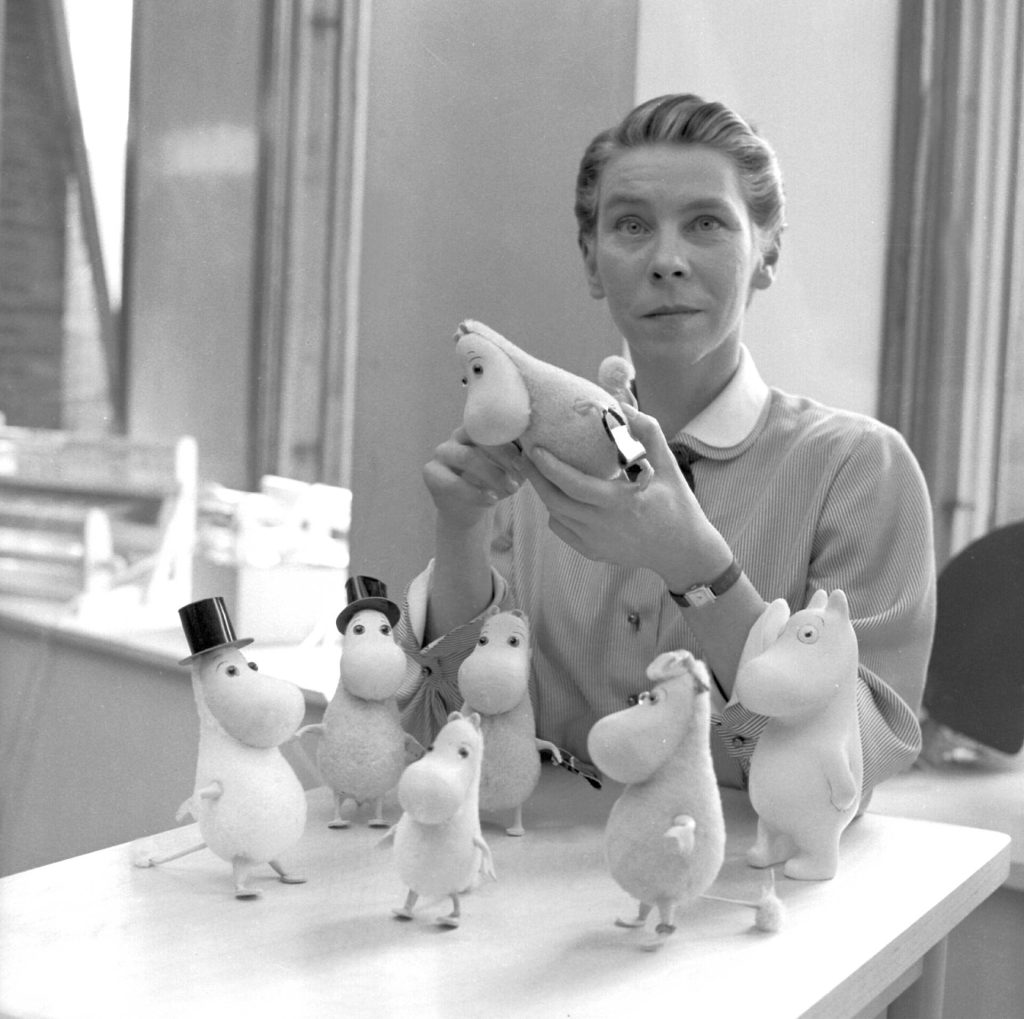 Tove Jansson and friends.
Tove Jansson and friends.
Jansson (who died in 2001) was a Finnish artist and writer who is probably best known (outside of Scandinavia, anyway) for the eight “Moomin” children’s fantasies she wrote beginning in the mid-1940’s and ending with the last volume in 1970. Set in Moominland and featuring the Moomin family and their eccentric friends (Moomins look sort of like hippos, or ambulatory marshmallows), the books are whimsical, dreamlike, gentle, satirical and sinister, all at the same time. I only recently discovered them, and I find them disquieting and delightful, which is one of the best combinations going.
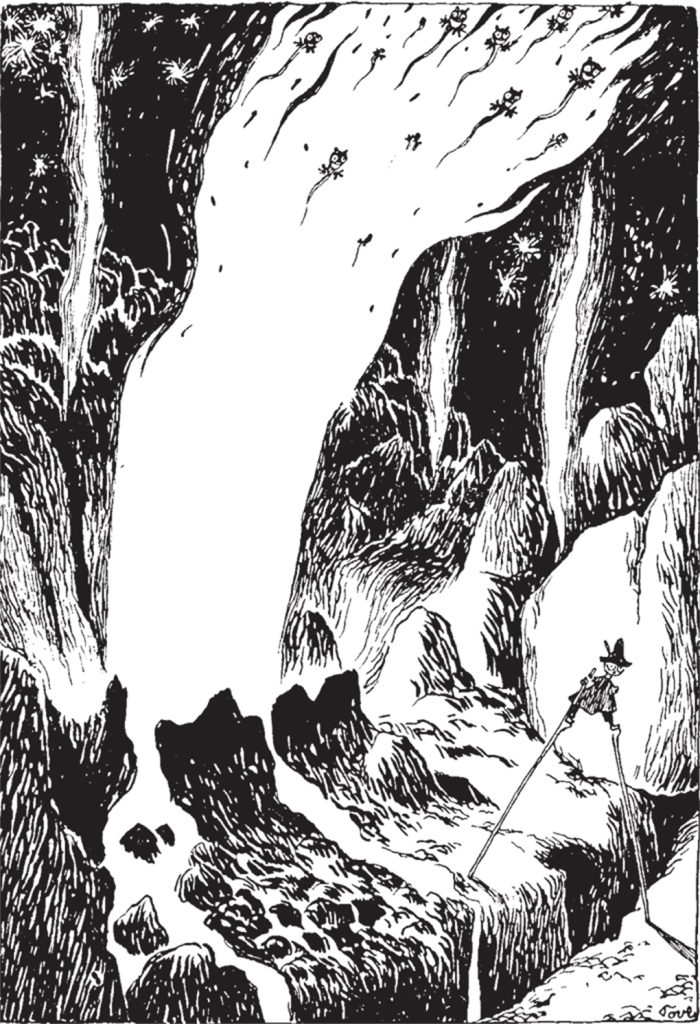 From Comet in Moominland. ©the estate of Tove Jansson
From Comet in Moominland. ©the estate of Tove Jansson
Jansson illustrated the Moomin stories herself, and her pen-and-ink drawings are some of the best things about the books. The illustrations for the first book in the series, Comet in Moominland, are especially striking; some of them are a cross between a kind of nightmare Lovecraftian landscape and the surreal imagery of William Hope Hodgson’s The Night Land.
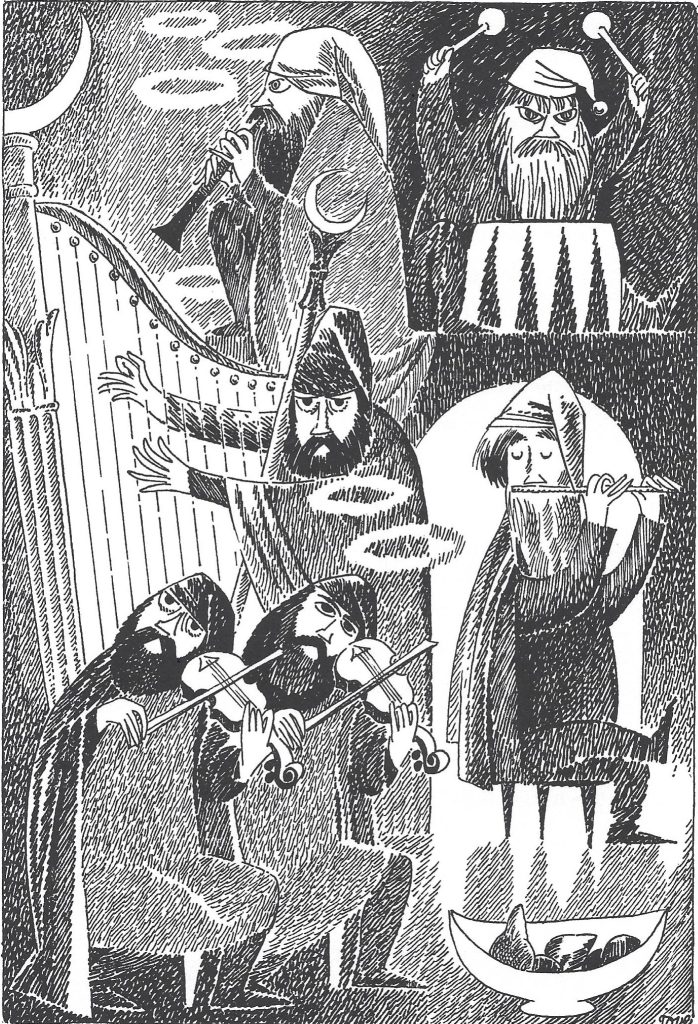 The Dwarves. ©the estate of Tove Jansson
The Dwarves. ©the estate of Tove Jansson
Though I’ve steadily been working my way through the Moomin books, I wasn’t aware until I had the Finnish Hobitti in my hands that Jansson had illustrated anyone else’s work. One look at her gorgeous cover illustration made me glad that she did. (There will always be a special place in my heart for a rampaging dragon.)
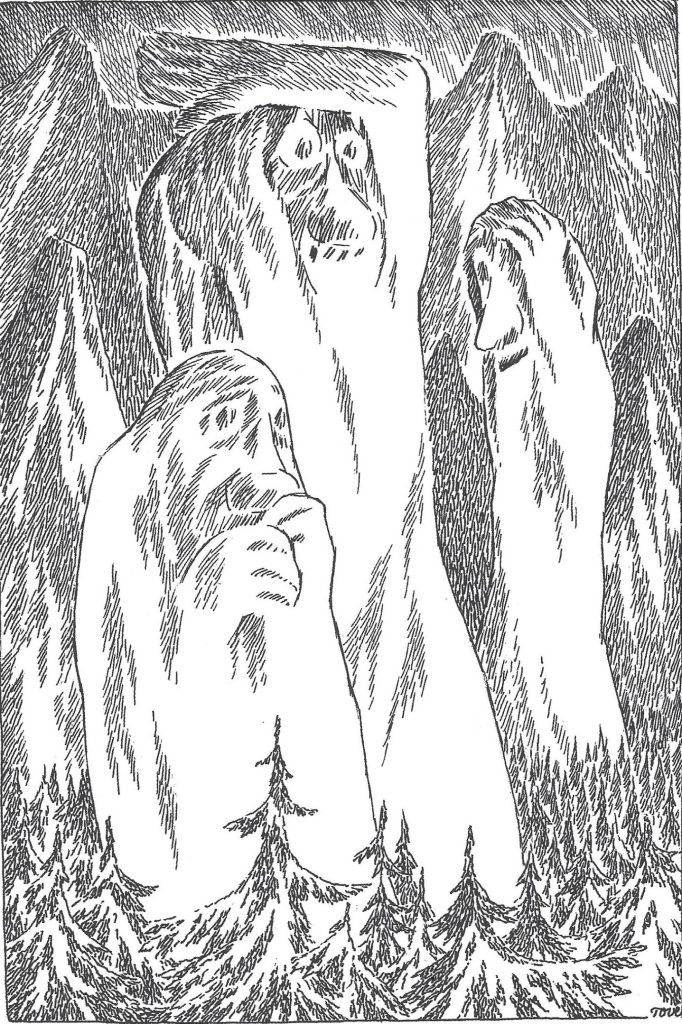 The Trolls. ©the estate of Tove Jansson
The Trolls. ©the estate of Tove Jansson
Jansson did her Hobbit illustrations for a 1962 Swedish edition (she was a member of Finland’s Swedish-speaking minority community) and they are refreshingly different from the more realistic renderings of Middle-earth and its inhabitants that are common today. She did twelve full-page black-and-white drawings for the book, another ten that cover half to a third of a page, and many smaller drawings that decorate the beginning or end of chapters.
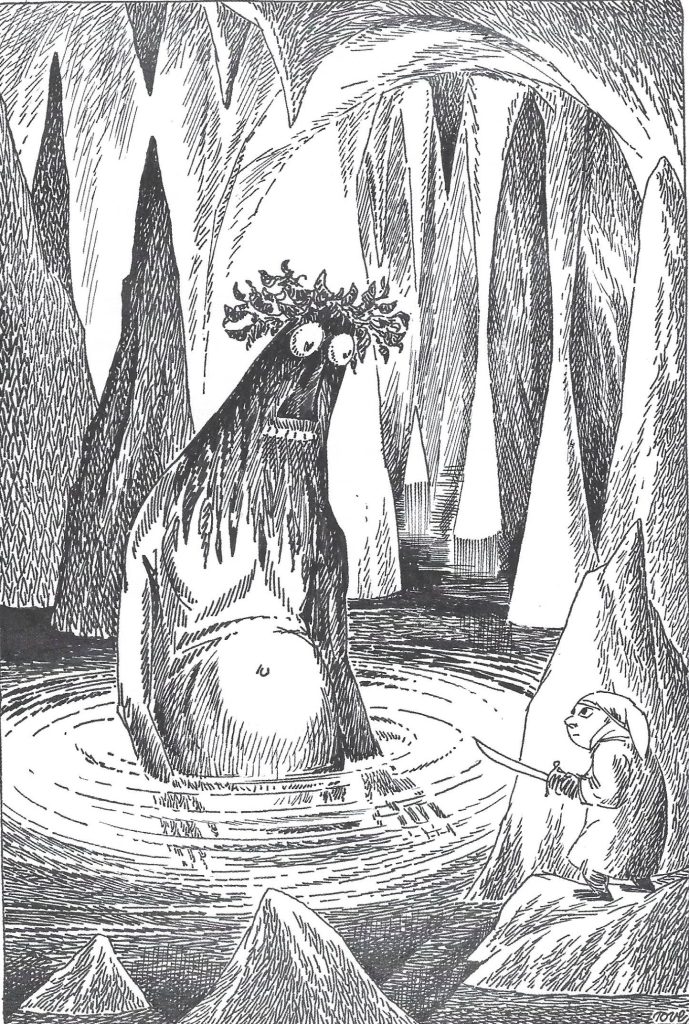 Bilbo and Gollum. ©the estate of Tove Jansson
Bilbo and Gollum. ©the estate of Tove Jansson
One thing that will immediately stand out to any Tolkien lover who flips through Jansson’s Hobitti is her visualization of Gollum. In Jansson’s drawings he’s huge, towering over Bilbo, and when Tolkien saw these illustrations, he supposedly realized that he had never specified exactly how large the slimy creature was, and so made the appropriate corrections for the Hobbit’s next edition, cutting Bilbo’s antagonist down to size.
 The Wargs. ©the estate of Tove Jansson
The Wargs. ©the estate of Tove Jansson
Jansson’s Tolkien illustrations are all her own; they’re not like any other rendition of Middle-earth that I can think of, and in comparing these wonderful pictures with more current ones, you can glimpse an older tradition, one that has its roots in the “North” that Tolkien loved, one that goes back to the sagas and Norse eddas that gave him his inspiration.
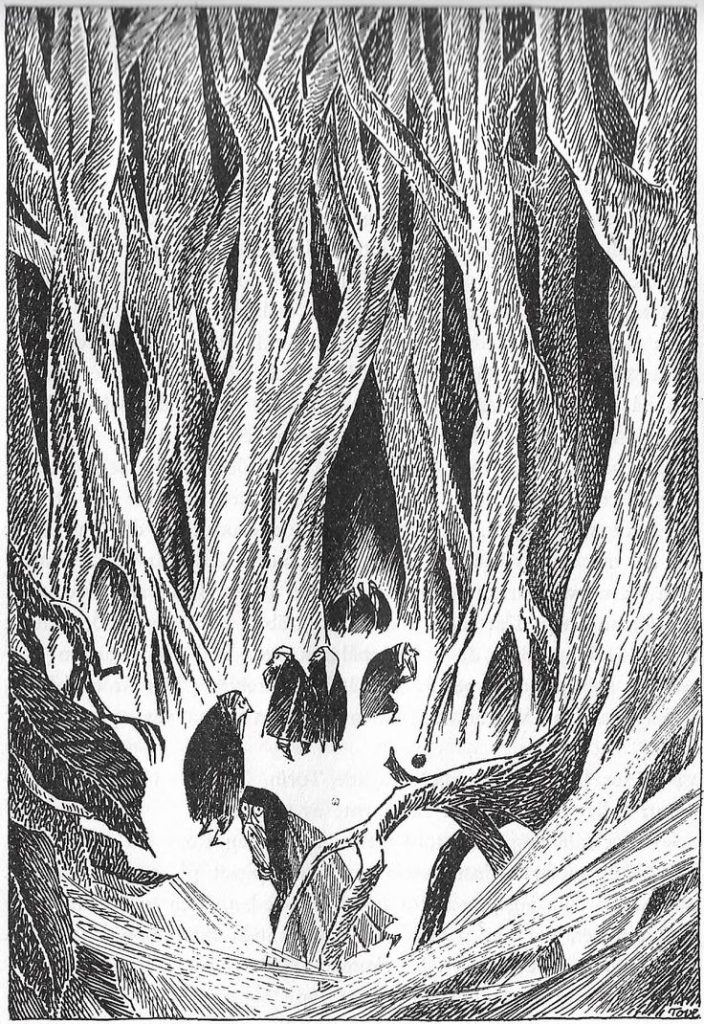 Mirkwood. ©the estate of Tove Jansson
Mirkwood. ©the estate of Tove Jansson
These simple-looking illustrations may not be to the taste of folks raised on fantasy photorealism (of course, in the hands of a true artist, there are few things deeper and more nuanced than simplicity), but I love them; their bold, expressionist lines combine the weird and the whimsical, the humorous and the beautiful, all with echoes of the heroic and the epic. I think Tove Jansson was a perfect match for Tolkien and his world.
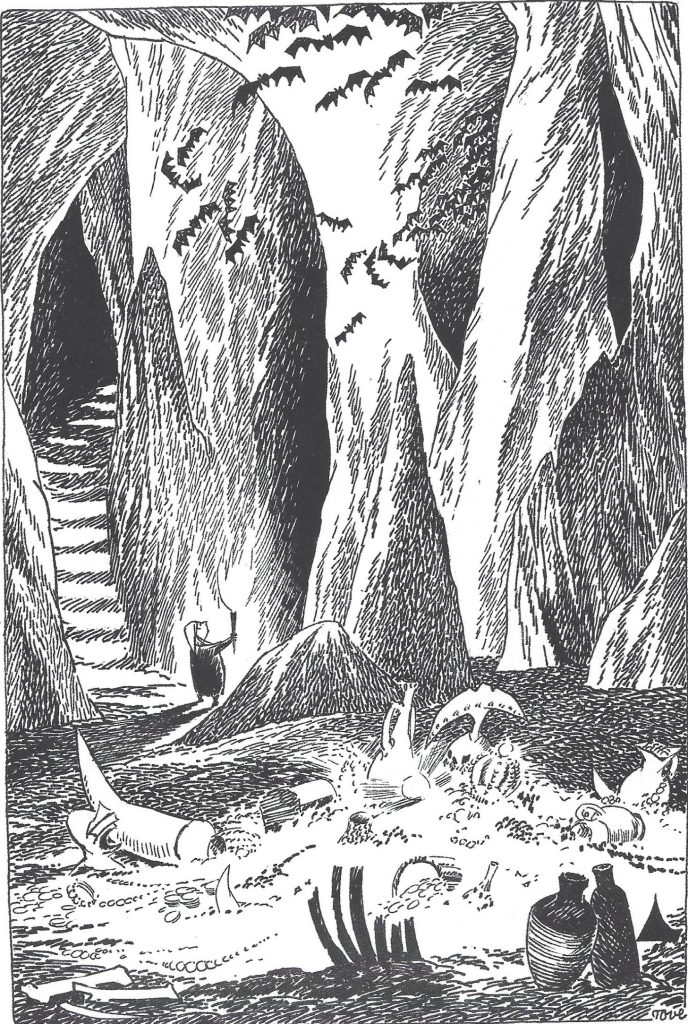 Smaug’s Treasure. ©the estate of Tove Jansson
Smaug’s Treasure. ©the estate of Tove Jansson
Just the other day I found out that Jansson did illustrations for Lewis Carrol’s Alice’s Adventures in Wonderland; NYRB Classics has just published a new edition featuring her drawings. Seeing what sparks Carrol’s story struck from Jansson is a rabbit hole I can’t wait to go down.
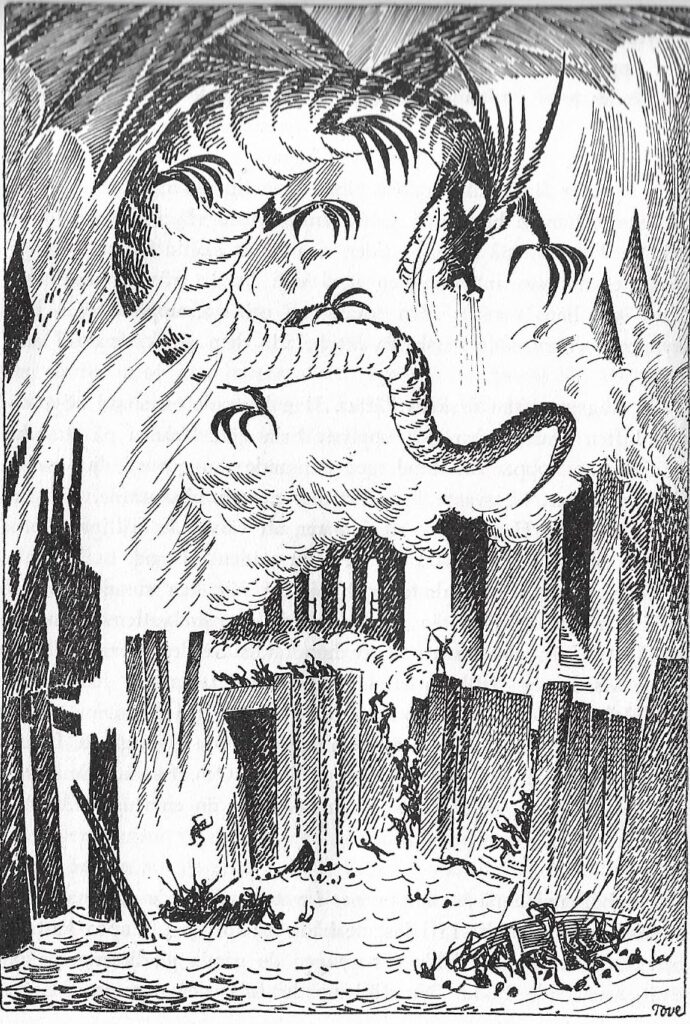 Smaug destroys Lake-Town. ©the estate of Tove Jansson
Smaug destroys Lake-Town. ©the estate of Tove Jansson
Until I can report back on Jansson’s Alice, I commend her Hobitti to you (her Moomin books, too), and I leave you with this:
Kaikki asekuntoiset ihmismiehet ja suurin osa haltiakuninkaan joukoista valmistautuivat marssimaan pohjoiseen Vuorta kohti. (What does that mean? I dunno, but it comes at the end of chapter Tulta Ja Vettä.)
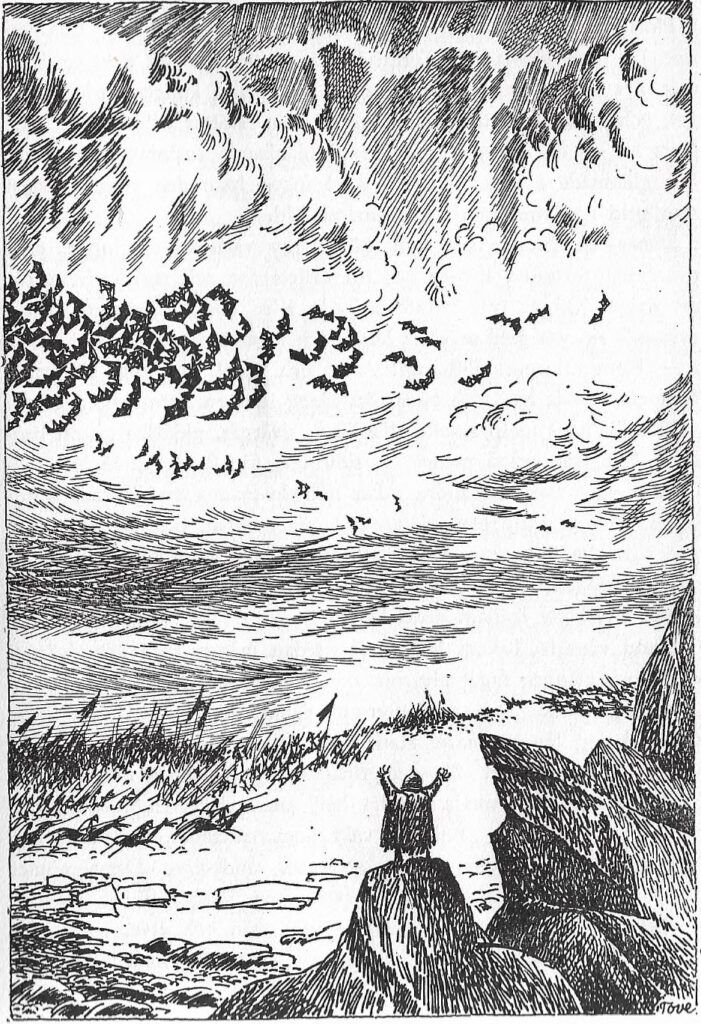 The Battle of Five Armies. ©the estate of Tove Jansson
The Battle of Five Armies. ©the estate of Tove Jansson
Thomas Parker is a native Southern Californian and a lifelong science fiction, fantasy, and mystery fan. When not corrupting the next generation as a fourth grade teacher, he collects Roger Corman movies, Silver Age comic books, Ace doubles, and despairing looks from his wife. His last article for us was The Lost World
7 Author Shoutouts | Authors We Love To Recommend
Here are 7 Author Shoutouts for this week. Find your favorite author or discover an…
The post 7 Author Shoutouts | Authors We Love To Recommend appeared first on LitStack.
Review: The Incandescent by Emily Tesh

Buy The Incandescent FORMAT/INFO: The Incandescent was published by Tor Books on May 13th, 2025. It is 432 pages long and is available in hardcover, ebook, and audiobook formats.
OVERVIEW/ANALYSIS: As the Director of Magic at Chetwood Academy, one of the most prestigious boarding schools in England, Dr. Walden's day is full of everything from faculty meetings to demons trying to break through the school's wards. She is constantly torn between keeping up on mundane admin while trying to stop idiot teenagers from messing with magic beyond their capabilities. But what is Dr. Walden to do when the greatest threat to the school might be herself?
The Incandescent is a fresh spin on the magical academia genre, where the overworked, underpaid faculty at an elite boarding school get to shine front and center. Nearly, if not all, magical academia books I have read have been from the POV of the students. I've seen plenty of books where a group of scrappy teenagers discovers a dark conspiracy afoot at their school. They sneak behind teachers' backs, dabble in a bit of forbidden magic or research, and generally defy authority, all in the name of saving the day.
But let's face it, many teenagers aren't noble heroes on a quest - they're idiots. Enter the exasperated staff of Chetwood Academy, trying to help shape students on their quest to discover their path in life, while also making sure they don't fall prey to demonic possession because they cut corners while drawing a summoning diagram. Dr. Walden and her staff are just as often trying to save the students from themselves as much as from outside threats, all while grading papers, offering career counseling, and managing the school's budget.
The Incandescent also takes a moment to examine and critique the whole structure of elitist boarding school culture. It examines the notion that what parents aren't paying for isn't really a top tier education; they're paying for their child to join the network of alumni scattered across the country and use that network for the rest of their lives. It's the social connections that truly matter to most parents, the security of knowing their child will have plenty of contacts who will open doors for them in the future. This in turn perpetuates systemic class disparities, as most often only those who can pay for the connections, get the connections.
I want to take a moment to note that while the marketing for this book makes a point of mentioning this is a sapphic story, you shouldn't expect a sweeping romance. Relationships are just one part of Dr. Walden's life, and certainly not the focus - which is good, because I found those romance dynamics one of the weaker parts of the story. On the one hand, I liked that Dr. Walden is grappling with the complications of juggling potential romance with the demands of her career. But there was just no chemistry between Dr. Walden and her love interest, leaving not particularly interested in what happened on that front.
CONCLUSION: The Incandescent is a worthy addition to the shelves of magical academia, and any fan of the genre should give it a read. It examines school culture from the rare perspective of the teacher, but it doesn't put forth that the teachers have all the answers; one of the best scenes is a student who challenges Dr. Walden's notion of how well their life situation and an elite boarding school education track go together. It gives you food for thought while also being an entertaining blend of school exams and demonic invasions, making The Incandescent a definite recommend.
Review of The Knight and the Moth by Rachel Gillig
As a Bookshop affiliate, I earn from qualifying purchases. The Knight and the Moth is the first book in The Stonewater Kingdom, a new gothic/romantic fantasy series by New York Times bestselling author Rachel Gillig. This was one of my most anticipated books of 2025 because One Dark Window, the author’s debut novel and the first book in The Shepherd King duology, was a fun, difficult-to-put-down story—and, as such, was one of my favorite books of 2022. Unfortunately, I was […]
The post Review of The Knight and the Moth by Rachel Gillig first appeared on Fantasy Cafe.Nosferatu: Was It the Time Change What Killed The Beast?
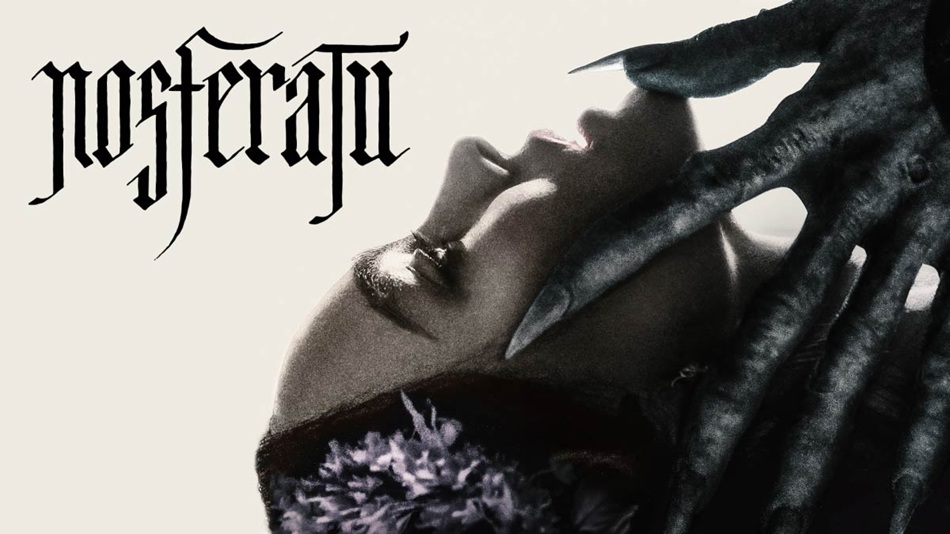 Nosferatu, written and directed by Robert Eggers, based on Nosferatu: A Symphony of Horror (1922), written by Henrik Galeen, and Dracula, penned by Bram Stoker in 1897.
Reboots and Adaptations
Nosferatu, written and directed by Robert Eggers, based on Nosferatu: A Symphony of Horror (1922), written by Henrik Galeen, and Dracula, penned by Bram Stoker in 1897.
Reboots and Adaptations
Okay. So I finally got around to watching Eggers’ version of FW Murnau’s classic from 1922, Nosferatu: A Symphony of Horror. By now, I think everyone knows the story behind FW Murnau’s Nosferatu, but here’s a brief summary: Murnau’s Nosferatu was an unauthorized adaptation of Bram Stoker’s Dracula, changing character names and locations but retaining the core plot elements. The film, which originally claimed to be adapted from Stoker’s novel, was made to avoid copyright issues and was eventually subject to legal action that nearly destroyed all prints.
Despite the name changes and some alterations, the film’s narrative largely follows Dracula’s journey, with the protagonist, Count Orlok (instead of Dracula), traveling to a new land — Romania to Germany, instead of Transylvania to England — and spreading a plague. Eggers’ reboot is definitely well made and impressive, and it has an other-worldly feel to it. It’s different from other vampire films. That being said, the original silent version is way creepier.
Now, allow me to digress for a paragraph or so. In 1979, there was a remake of the film — Nosferatu the Vampyre, known in Germany as Nosferatu: Phantom of the Night — directed by Werner Herzog and starring Klaus Kinski as Count Dracula. Yes, all Stoker’s character names were used in this film version. Not a bad film, but a bit anemic, you should pardon the pun. There’s also a fun flick from 2000 called Shadow of the Vampire, a fictional telling of the making of the silent Nosferatu, in which Willem Dafoe (who also has a role in Eggers’ version) stars as Max Schreck, the real name of the actor who first played Nosferatu. The twist is this: Max Schreck is a real vampire — a vampire playing a human actor who’s playing a vampire. (Sort of a Victor/Victoria, with blood.) Now where was I? Oh, yeah.
Expect SexFirst off… yes, sex is at the heart of Eggers’ Nosferatu. Sex is at the heart of Stoker’s novel, which was written in the sexually repressed Victorian Era. Sex plays a part in almost every vampire film I’ve ever seen. Francis Ford Coppola’s Bram Stoker’s Dracula (1992), for example, is loaded with sex and nudity, like the Three Brides feeding on Keanu Reeves, one of whom is Monica Bellucci. There’s also a wild scene between Dracula (Gary Oldman), in wolf manifestation, humping Lucy Westenra (Sadie Frost.) Then there’s the love scene between Mina Harker (Winona Ryder) and Dracula, where she licks his blood off his chest.
So there’s nothing new on the sexual theme and subtext of this latest version of Nosferatu. In fact, Nosferatu owes a lot to Coppola’s Dracula, a film I am quite fond of, in spite of some cringe-worthy acting, dialog and miscasting. Gary Oldman was fantastic; he owns that role and that film, just as Lily-Rose Depp, the real star of Nosferatu, owns this film. I’ll come back to her.
AtmosphereEggers’ Nosferatu owes a lot to Coppola’s Dracula in its use of shadows and some “camera tricks.” It also boasts some exquisite scenery and set design, which convey the ideal atmosphere for the story. The cinematography by Jarin Blaschke is masterful, the film score by Robin Carolan is spot on, and there are some haunting audio FX that add to the grimness of this film. The script pretty much follows the plot of the original screenplay by Henrik Galeen, but doesn’t owe much to Bram Stoker, other than his novel being the inspiration for the original, silent film.
I found this extended version to be a bit — (a bite?) — too long (in the tooth?) because it was almost deadly-dull at times. It moved as slowly as a corpse first waking up as one of the Walking Dead. The film spent too much time on mood and set up, and the first two acts I found to be somewhat tedious and boring. Not enough was happening! I did not find it at all exciting. It was like watching a pair of heroin addicts playing chess. The third act picked up some energy, but by then I was yawning. The plague of rats was pretty cool, though. There are a lot of rats in this film. I mean, a lot of rats.
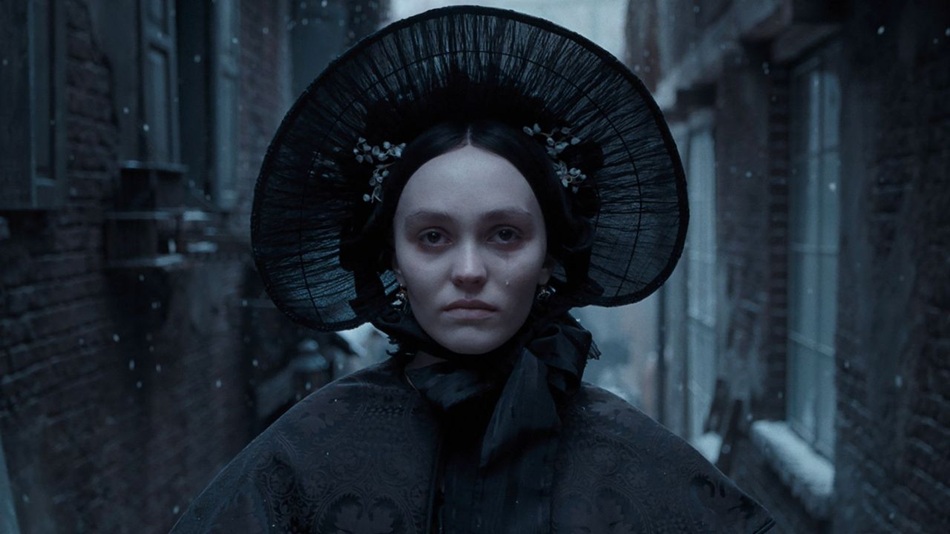 Lily Rose from Nosferatu 2024
Casting
Lily Rose from Nosferatu 2024
Casting
The cast was capable but not exceptional. They did their jobs and they did well enough. Willem Dafoe did a stand-up job, however, and in only one brief scene does he go over the top. I just couldn’t get emotionally attached or involved with any of the characters — except for Lily-Rose Depp. This is her film and she totally owns it. Her performance as Ellen Hutter (Mina Harker, in Stoker’s novel) is powerful and spot-on in every scene. She nails it and steals the show. She is put through the emotional ringer in this film — loving, angelic, quirky, possessed, demonic — you name it, she throws it all up there on the screen. She blew me away with a solid, heroic performance that was never over-the-top. She was brilliant. Her self-sacrifice in the final act is a powerful scene, and a sad one, as well.
As for the two kids who play the children of Anna Harding and Frederich Harding (Emma Corrin and Aaron Taylor-Johnson) I found them to be as annoying as a blister on the tip of my big toe, and when Nosferatu feeds on them, I cheered him on. It’s a brief, darkly-lit scene that quickly shift’s to Anna who sees her children being devoured, and the look on her face and her scream of horror, followed by her final fate, is chilling. That was a good bit. As for Bill Skarsgård, the other major player in Nosferatu and the title character…
I’m a fan. I’ve enjoyed his work in such films as John Wick, The Crow, and as Pennywise in the theatrical version of Stephen King’s IT — a feat of acting that, considering Tim Curry’s wonderful Pennywise, I applauded because he made the role his own: his Pennywise was the only good thing about that version of King’s novel.
But as for his take as Nosferatu… it didn’t work for me at all. I did not care for the make-up or the way he portrayed the character. There was nothing “supernatural” about him. He was just a force of evil, more like a big, hulking brute… and maybe that’s what Eggers wanted. I know The Last Voyage of the Demeter was not very well received, but I enjoyed that film and got a genuine sense of Dracula as being demonic, sorcerous, powerful, and evil. I didn’t get any sense of what Nosferatu felt for Ellen (Mina), no lost love, no real idea of why he wanted her, nothing about her being the reincarnation of a lost love. He says something about her not being of this world, of not being human or belonging to the living world — whatever. I must have missed something about how they were connected, but I’m not going back to “watch again,” at least not for the time being.
When Skarsgård’s dialog was in Romanian, it was subtitled in English. But when he spoke English, his accent was very difficult for me to understand. I was like, “What the hell is he talking about?” I kept expecting the villagers from Young Frankenstein to show up and shout in unison: WHAT?
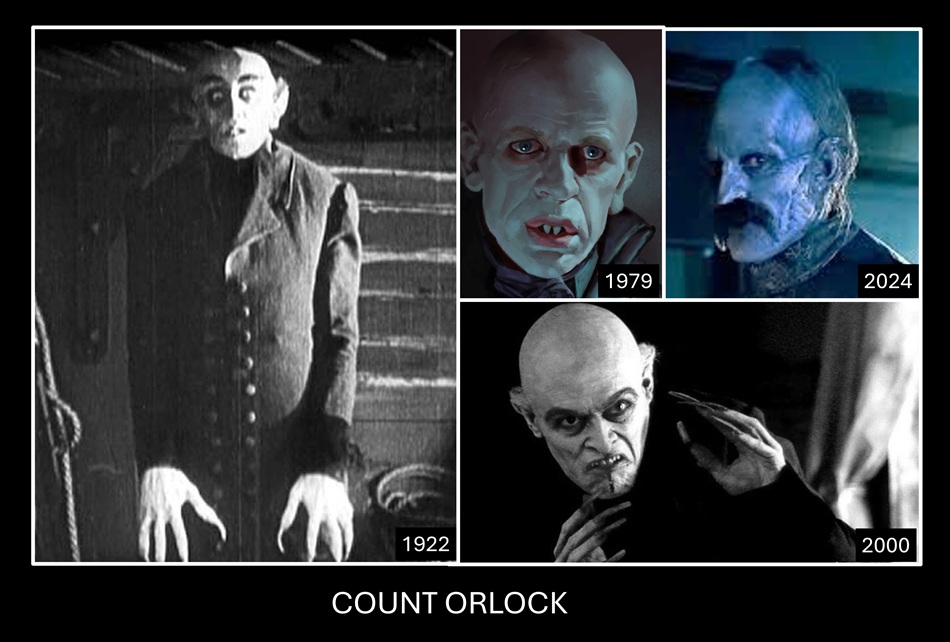 1922 MAX SCHRECK Nosferatu; 1979 KLAUS KINSKI Nosferatu the Vampyre; 2000 WILLEM DAFOE Shadow of the Vampire; 2024 Bill Skarsgård Nosferatu
Omnipotent Vampire Ignores Chicken, Dies
1922 MAX SCHRECK Nosferatu; 1979 KLAUS KINSKI Nosferatu the Vampyre; 2000 WILLEM DAFOE Shadow of the Vampire; 2024 Bill Skarsgård Nosferatu
Omnipotent Vampire Ignores Chicken, Dies
Now, here’s the problem I always had with the original version of Nosferatu, and with this one, too. I find it funny that an ancient, demonic, powerful vampire could become so besotted with blood and sex that he doesn’t see the sun rising and doesn’t pay attention to the cock’s first crowing. By the time of the second crowing, it’s too late. Didn’t he see or feel the sunlight shining through that honking-big window? Did he leave his watch at home? Did he forget about the time change? Or… maybe he knew that there was nowhere he could run and hide, because the coffin(s) full of his native soil had been destroyed. Or was this his fate, his desire — to perish in the arms of Ellen Hutter? I think that was it, because he could have let anyone destroy him at any time, if he wanted death and oblivion, but he wanted her to be his doom, he wanted to take her with him, to be with him forever in death. But what do I know? I’m not a real film critic. I’m just hear to entertain you Black Gate readers.
Check Out My DisappointmentI do not hate or dislike this version of Nosferatu. I am just disappointed in it. All the hype about this film, the word-of-mouth, gave me expectations of something I imagined would be a revelation, a landmark in moving pictures and vampire flicks in general. Thus, not getting what I expected, I was disappointed. It happens. And that’s on me. But if you haven’t seen the film, don’t let my review stop you from doing so. Check it out. You might like it. I’m sure I’ll watch the film again. Maybe it will grow on me. There are many favorite films I did not enjoy on first viewing, and vice versa, too. Anyway, Nosferatu was a big hit, it’s popular and made lots of $$$$$, so that should tell you something. One thing I do know… Lily-Rose Depp is going to have one helluva fine film career. I look forward to seeing her in more films.
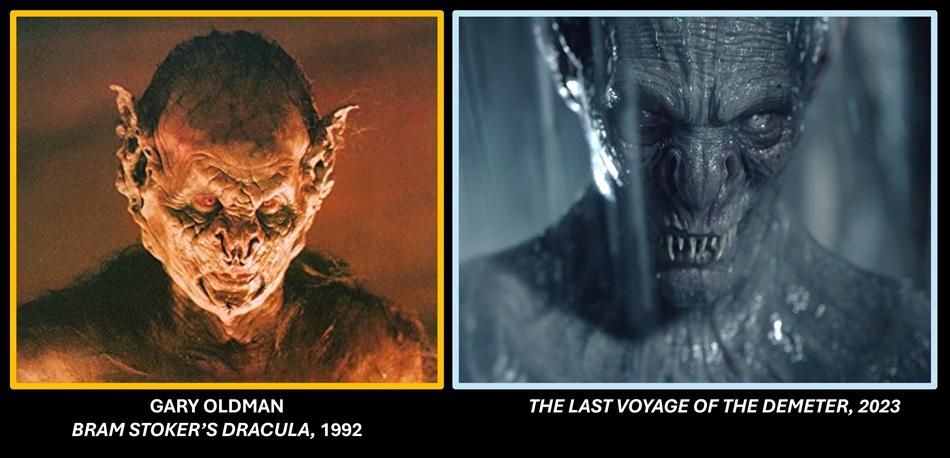 Left: GARY OLDMAN – BRAM STOKER’S DRACULA, 1992 Right: THE LAST VOYAGE OF THE DEMETER, 2023
Left: GARY OLDMAN – BRAM STOKER’S DRACULA, 1992 Right: THE LAST VOYAGE OF THE DEMETER, 2023
Joe Bonadonna is the author of the heroic fantasies Mad Shadows — Book One: The Weird Tales of Dorgo the Dowser(winner of the 2017 Golden Book Readers’ Choice Award for Fantasy); Mad Shadows — Book Two: The Order of the Serpent; Mad Shadows — Book Three: The Heroes of Echo Gate; the space operaThree Against the Stars and its sequel, the sword and planet space adventure, The MechMen of Canis-9; and the sword & sorcery pirate novel, Waters of Darkness, in collaboration with David C. Smith. With co-writer Erika M Szabo, he penned Three Ghosts in a Black Pumpkin (winner of the 2017 Golden Books Judge’s Choice Award for Children’s Fantasy), and its sequel, The Power of the Sapphire Wand.
He also has stories appearing in: Azieran: Artifacts and Relics; Savage Realms Monthly (March 2022); Griots 2: Sisters of the Spear; Heroika I: Dragon Eaters; Poets in Hell; Doctors in Hell; Pirates in Hell; Lovers in Hell; Mystics in Hell; Liars in Hell; Sinbad: The New Voyages, Volume 4; Unbreakable Ink; Poetry for Peace; the shared-world anthology Sha’Daa: Toys, in collaboration with author Shebat Legion; and with David C. Smith for the shared-universe anthology, The Lost Empire of Sol.
In addition to his fiction, Joe has written numerous articles, book reviews and author interviews for Black Gate online magazine.
If You Can’t Win, Bribe
Last night, in the middle of the tornado warning alert and our phones and our alarm system screaming in unison that a tornado is imminent:
Gordon: Is that a tornado siren of a flash flood siren?
Me: Who knows?
Kid 2. Kid 2 knows. They used to just do sirens for the tornados, but now they added flash floods, and so the tone of the siren is different. Apparently, that was the flash flood siren.
We’d managed to catch Batty, our outside cat, and secured her in the laundry room. The trust is broken again, and she will have to get over it for the next 6 months, but she didn’t fly into the storm. The tornado and hail missed us, so hey, it’s a good day. So on brand for Central Texas though. Any other day – sunny, hot, blue sky. Memorial and 4th of July – massive thunderstorm every year.
Gordon is recovering from surgery. We had to take the original bandage off and sealed the incision sites with waterproof bandages so he could take a shower, and his incisions are dry, the right color, and seem to be healing well. He can raise his arm all the way up, but the shoulder is still tight. He’s been going to physical therapy and his post-op is next week. Hopefully they will clear him for swimming, because that really seemed to help.
Yesterday Grace Draven came over before the storm, and we hung out and talked shop. I’m so excited for the new novella she is working on. It’s a brand new world and it is so shiny.
In other news, we are engaged in a tower-defense military campaign called, “Protect the bird feeder.” We both really like watching birds from the office window, so we set up a birdfeeder. We get all kind of birds and it’s awesome. We also get squirrels and the deer, who wreck the birdfeeder. The deer are the worst, so we now installed some strategic garden fencing around the bird feeder in concentric circles so they can’t step over it.
The squirrels are a bigger problem. Protecting against them is impossible so instead we settled for the misdirection.
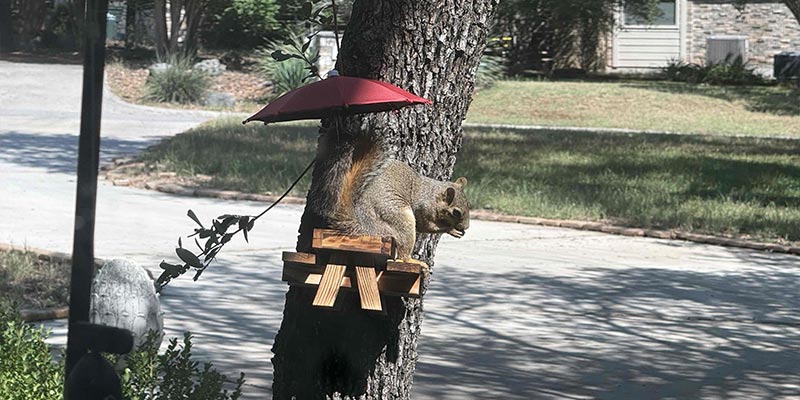
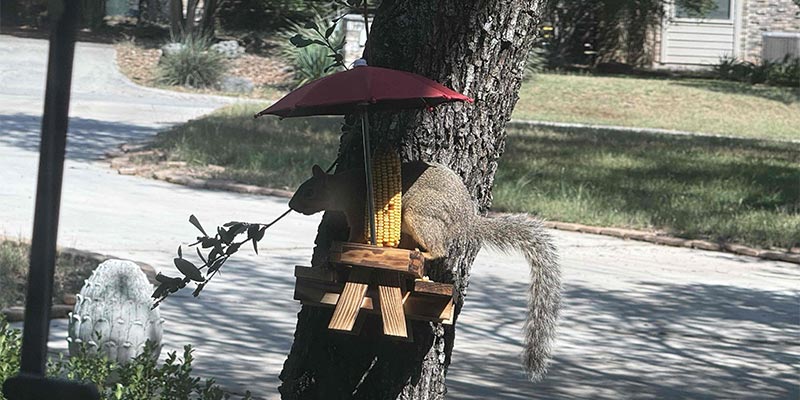
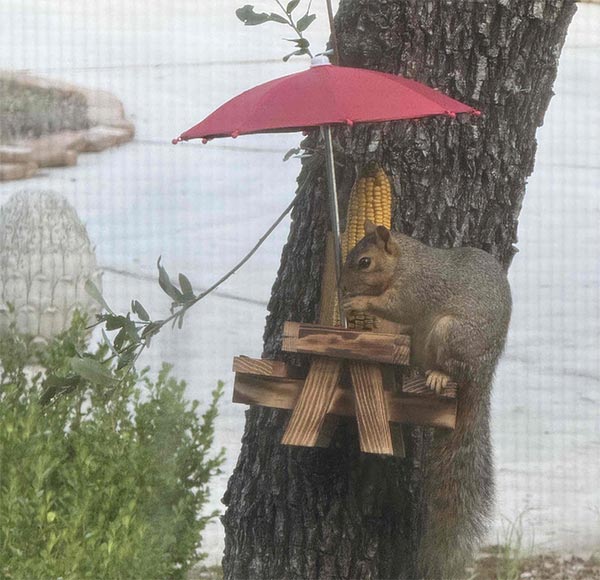
Look how cute he is at his picnic table.
The post If You Can’t Win, Bribe first appeared on ILONA ANDREWS.
Heir of Light pub day!
“Measure of Devotion” Measuring an Outcome | Love, War, and Surrender
LitStack is excited to share Allie Coker’s review, an engaging exploration of the characters, key…
The post “Measure of Devotion” Measuring an Outcome | Love, War, and Surrender appeared first on LitStack.
THE NIGHT BIRDS by Christopher Golden
Free Fiction Monday: The Demise of Snot Rocket
All serious runners know about snot rockets. At least in pre-pandemic times, they did.
But one particularly talented runner relishes snot rockets more than others.
When he turns up dead, the list of potential murderers runs longer than the list of medals he collected over the years.
But when an investigative journalist sees the true crime potential of the case, what she uncovers surprises even her.
“The Demise of Snot Rocket“ is available for one week on this site. The ebook is available on all retail stores, as well as here.
The Demise of Snot Rocket By Kristine Kathryn Rusch
Let’s be honest: It was gross even before the pandemic shut everything down and made us aware of just how dirty the world—and our habits—were.
Runners, especially distance runners, didn’t have time to blow their noses, so they would press one nostril closed, and forcibly exhale whatever was in the other nostril, while moving on a trail. Sometimes that exhalation worked, and sometimes it didn’t. If it didn’t, the runner wiped his sleeve (and yeah, “his.” It was usually a guy) across his face.
Anything to prevent stopping. Anything to preclude carrying tissue or wipes, which you couldn’t dispose of anyway on a trail. Sometimes you could toss the tissue into an open garbage can on a run in a neighborhood or an urban area, but that meant carrying the wet slimy thing for blocks or more, and no one did that.
Instead, they sent snot flying out their noses, and hoped no one would see it.
This happened so often that it had a name: The Snot Rocket.
Fun, right?
Not possible while wearing a mask. And afterwards—who knows? No one is confessing now. If snot rockets have returned, no one will admit to it, when they all laughed about it before.
This story takes place before.
Sometimes I wonder what would have happened if it had happened after. Would Snot Rocket have changed? Would he have coped? Would he have become even more obnoxious?
We will never know.
****
To clarify a few things: Yes, I knew a guy named Snot Rocket. Not named by his parents. Named by all of us in the city who raced (reluctantly) at his side. A few of us tried to have him banned from local races, but we couldn’t for two reasons.
- He was good. As in always finished in the top five good.
And…
- Everyone did it. Even the people who lied and said they didn’t do it.
I did it on one particularly long trail run when I was in the woods in the rain by myself and my nose wasn’t having it. My choice was a leaf or a snot rocket and, dear readers, I chose the rocket. The leaf could’ve given me poison ivy or poison oak or bugs or something. The snot rocket itself was a one and done.
It did leave me feeling…curiously elated.
I’m a woman of a certain age, raised by an OCD mother in a time before anyone knew what that was. I follow (most of) the rules, and that includes not expelling snot into the wild. (It also includes not discussing snot, but I think we’re beyond that in this post-2020 world, right? We discuss fluids and filth all the time now. All. The. Damn. Time.)
All those years of running track in junior high (yes, I’m old enough not to call it middle school), high school, and college—thank you very much—before Title IX funding amounted to much of anything. I wasn’t good enough to go on to regional and national competitions, where you actually got a bit of money.
But, in the early days of running, I was good enough to compete in local races with the men, often as one of the few women. Early on, I was in the top ten, but age eventually moved me to the top twenty and then the top thirty, and finally I became Queen of my Age Group, always smoking the other women in my age range by a significant, noticeable amount.
I can’t tell you when Snot Rocket joined our merry band of local runners. One day he was there, and the next day (probably) we were all discussing how disgusting he was.
It wasn’t just that he expelled goobers loudly and with great enthusiasm, it was also that he seemed to have an endless supply of them. It got so none of us ever wanted to run near him. Either side was a danger zone, and in front of him, well, sometimes you didn’t know you were hit until you got home and peeled off your sweaty race shirt.
He’d probably be arrested now. Arrested and charged with assault.
Back in the day, we discussed it—those of us who had to share the road with him. Half of us thought he used it as a race strategy to keep path clear.
When I ran past him (and I didn’t do it as frequently as I would have liked; he was faster than me), I would make sure I was at least a yard away from him—off trail, on the sidewalk, wherever I could go and still be on the path for the race, so I wouldn’t get disqualified.
Social distancing before we ever heard the term.
Of course, that zigging and zagging added a tiny bit of distance to my run, which I resented, and so did everyone else who used that same strategy. Some of the men claimed they didn’t care. They claimed they would run past him, and not worry, because they were already sweat-covered and dirty.
But I saw them in real time: they’d pass as far from him as possible, and if they were ahead of him, they had to expend extra energy just to keep the distance.
No one wanted to get too close. And I think that extra energy cost some of Snot Rocket’s competitors the race. They didn’t have anything left in the tank when they got close to the finish line, and he would zoom right past them.
There was no proving it, of course.
But Snot Rocket’s personal habits and his consistent wins did not endear him to the local runners. Particularly when he would brag to anyone who could stomach listening about how great he really was.
He had—he said—thousands of finisher medals. Some in boxes, and the best ones—the “coolest” ones hanging from hooks on his walls.
He died, with three of those medals around his neck, and no other medal in the house.
But I get ahead of myself.
***
I’m an investigative journalist. Not the kind you’re thinking of—the old-fashioned Woodward and Bernstein model, supported by a sympathetic paper filled with heroic and compassionate leaders who really didn’t care about the bottom line (and yes, that was fiction, but it was a fiction we all bought). I did work for the Gray Lady once upon a time, until her D.C. rival poached me. I stayed there until I’d had enough of the insularity and constant political doublethink. Then came the rabid nightmarish shock that was the first few months of the Trump era.
My marriage of long-standing broke up over (among other things) politics—his were red, mine weren’t. So, I quit the day job and moved west, heading to yet another storied newspaper just in time for it to get sold and close.
I landed on my feet more or less, and became part of an online collective that partners with media outlets all over the world. We do the research and some of us also do the writing, and both organizations get the credit.
It pays less than I made in D.C., but the work is more flexible, and the cost of living here is lower.
I ran back east, so it was only natural to join running organizations here. I signed up for every race I possibly could and as a result met the other slightly obsessive runners in the community, some of whom were fast like Snot Rocket and some of whom were nice, like the bulk of the folks running the show.
I didn’t get involved with anyone—wasn’t that interested, really—but had a pretty fulfilling life. Research, writing, and running, plus living in a place where I didn’t have to talk politics 24/7, made life a lot more pleasant than it had ever been before.
I also had the freedom to set my own schedule, which actually allowed me to run as many races as I could find. I preferred 10K because it was just long enough to challenge me, but short enough to allow me to have the rest of the day to do something else if I so chose.
It also meant that I got to meet a lot of elite runners, because 10Ks were usually attached to the big races. We had only three Boston Qualifiers in this city, but that was three more than most places.
I’d run Boston half a dozen times, including the year of the bombing. But Boston lost its allure for me, partly because I was on the team that ended up reporting the bombing. I heard stories of loss and heartache, heroism and strength, and pretended for those few years that it hadn’t had an impact on me.
But after I moved, and qualified in my age group, I couldn’t bring myself to go. It wasn’t an east-west thing either, or the idea that I had to travel long distances. My stomach knotted and my mouth went dry even thinking about it.
Every year, the Boston Qualifiers were fraught. Runners shoved their way into separate starting corrals, yelled at volunteers, and sometimes tried to shoehorn their way into a pace group they hadn’t signed up for.
I tried to stay out of their way, but that year, the year Snot Rocket died, I failed at keeping my distance.
That particular race had a new director who was a bit clueless. The corrals snaked through an industrial park, doubling back on themselves. Unlike most large races, the corrals didn’t have makeshift barriers to keep runners from sliding into another grouping. The director apparently expected people to police themselves.
My corral for the 10K was across a narrow strip of parking lot away from the lead-off runners for the actual marathon. My corral was quiet. Most people in a 10K maybe cared about a personal best, but they really weren’t there for a make-it-or-break-it chance to run the race of their dreams.
Those in the marathon line were there to win, or to PR and get in the race of their dreams, particularly those in that first corral. Like so many big races of its type, this one offered hefty prize money for the finishers. The qualifiers went down by age group, but the actual runners—the ones who traveled from city to city collecting trophies and prizes—well, they needed to focus on their race rather than some kind of squabble about times and spots in line.
I was just trying to focus on my race when I noticed Snot Rocket was in the middle of the shoving match.
I started watching like a kid drawn to a school fight. I actually had a dog in the hunt or skin in the game or whatever cliché you wanted to drum up. Not because I wanted Snot Rocket to win, but because I was curious about what he was up to.
He was screaming at one of the runners, spraying visible spittle all over him, just from the force of his verbal outburst. The runner—a tall skinny White guy, who looked like he ran professionally—screamed back.
I couldn’t make out the words, but these guys were serious. They were furious at each other.
Snot Rocket shoved the other guy first, right into the crowd of elite runners. They paid attention for the first time, glaring at the two of them. One of the exceptionally tall and thin runners, a man who looked vaguely familiar, raised his hand, and waved it—not to get the attention of Snot Rocket and the other guy, but to get the attention of the volunteers.
One of the volunteers responded immediately, which told me that the vague familiarity I felt actually meant something. The runner really was one of the elites, and more than that, one of the people the race was honored to have in its lineup.
That volunteer disappeared into the crowd, and I couldn’t follow his yellow jersey to see where he went, because I’m not exceptionally tall or tall in any way, shape or form.
Snot Rocket and his squabbling buddy didn’t even seem to notice. The squabbling buddy shoved Snot Rocket. Snot Rocket tripped backwards, and probably would have fallen if he hadn’t been in such good physical shape.
No one tried to break them up. No one wanted to get involved. Or maybe, no one wanted to get injured just before a race.
Finally, a couple of people wearing yellow security jerseys waded into the crowd. One of them grabbed Snot Rocket by the arm. He shook them off, and turned toward them, utterly furious. I was finally able to see his face.
“Get your fucking hands off me,” he said loud enough for me to hear.
The security official said something in response, and reached toward Snot Rocket’s bib. Snot Rocket stepped backwards again, only this time he backed into another security official.
Two more security officials were talking with Snot Rocket’s opponent. The opponent shook them off and tried to move forward in the crowd, but the crowd closed around him. No one let him get to the front of the line.
Snot Rocket wasn’t watching any of that. He was arguing with security now, only softer, so I couldn’t hear.
“Never seen that before,” said the woman next to me. She was thin and slight and wore the race T-shirt with an additional tech shirt underneath. It promised to be cool for this run, but I never wore the extra shirt. I always got too hot at races.
“Me, either,” I said and turned away, so that I could see the rest of the fight. Only the fight was done now. Snot Rocket was being led down that strip of unmarked parking lot, walking between two security officials, his head down.
I couldn’t see Snot Rocket’s opponent anymore, but the crowd had closed back up, and they were all facing forward, going through their pre-race rituals while they waited for their corral’s starting gun.
“I wonder what that was all about,” the woman next to me said.
I could have told her about Snot Rocket, about how unpleasant he was and had always been. I could have engaged in polite speculation, since we had to wait another thirty minutes before we started moving—provided the 10K went off on time. That would depend on the full and half marathoners.
Technically, we started on a different block from the full and half folks, and went a completely different direction to stay out of their way. We’d join each other nine miles into their race—and then our group would veer off, and head toward the finish line via a different route again.
I didn’t expect to see Snot Rocket again, because he was a marathoner and, I thought, had just managed to get himself disqualified from the race.
But I did see him, just before I joined the marathoners at mile marker nine (the race used the marathon numbers, not numbers for the rest of us). He was loping like he always did, making it look easy. His hair flowed backwards, his arms were relaxed at his side, and he had a half-smile on his face.
He looked nothing like the man who had been shouting so loudly that spit came out of his mouth. He actually looked content.
I watched him run as the road I was on headed toward the road he was on, and I envied his perfect stride. I didn’t register anything else except a mild curiosity about how he managed to stay in the race after that egotistical display and why he was looking so content with himself.
I had been a bit unsettled from his fight; I would have expected him to be more than a bit unsettled. I would have expected him to be deeply disturbed, maybe running a bit too fast to get rid of the adrenaline from the fight itself.
And then I joined the crowd and didn’t think about him at all. I concentrated on finding my lane, where I could keep a steady pace and stay out of the way of the full and half marathoners who didn’t need some pokey 10K runner to screw up their PR.
That’s the thing about running. People are polite, generally. And if they have conflicts, they leave them off the course. This isn’t one of those confrontational sports like hockey or football. It’s something most people do for themselves, including the elites. Yeah, there’s money involved, but mostly, there’s bragging rights. And bragging rights mean even more.
And that was all the thought I gave him that morning. Maybe I didn’t even go that far. I enjoyed my race, got my finisher medal, noted that I had won my age group, and waited for the 10K medal ceremony, which was taking place long before any of the full marathoners even thought of crossing the finish line.
Then I went home, finished up an article on the impact of California fuel regulations (sometimes my job is not fun), and poured myself a glass of California chardonnay to celebrate a good day well lived.
The next day, the authorities found Snot Rocket dead. Strangled in the living room of his own house.
***
Of course, I didn’t find out for nearly a week. I didn’t know Snot Rocket’s real name; I never had the desire to ferret it out. So when people talked about Dave dying, I didn’t know that Dave—he of the very ordinary and forgettable name—was Snot Rocket.
I didn’t learn that until the running group met at our favorite park for our 7 a.m. weekend run, and we were greeted by an exhausted-looking detective.
He was sitting on a concrete picnic table—on the table itself, feet on the concrete bench. He clutched an extra-large to-go cup of coffee like a lifeline. He actually wore a suit, although it was cheap and baggy, as if he had lost weight due to a serious health condition. His hair was thin, and his face was thinner. The suit called attention to him—who wore a suit to a park at this time of the morning?
We all shot him nervous looks as we mingled and talked. And when zero hour arrived—7 a.m. on the nose—he stood up and ambled over to us.
I cringed. I always do when a non-runner stranger decides to talk with our group. That person usually wants to know what running is like or if we’re racing or how he can actually get into the daily habit without doing any of the work.
Only this guy flashed a badge, introduced himself as Detective Conners, and said he was looking into the death of Dave Pyron. Most of us glanced at each other in confusion, and probably would’ve told Conners that we didn’t know any Pyron, until Roscoe Carter raised his extremely thin eyebrows and said, “You mean Snot Rocket, right?”
We all whipped our heads toward him, and a few of us expressed incredulity that Snot Rocket was named Dave. Finally, Conners hauled out a photograph—fortunately one taken from Snot Rocket’s house, not the photo of him strangled—and we had to agree: yep, Dave and Snot Rocket were one.
None of us wanted to give up our morning run, so we invited Conners to join us, which he declined. Instead, he offered to interview us one by one as we returned. Apparently, he too thought this was a race, not a group venture. A few people normally would have sprinted out, but no one did this time, because no one wanted to be first to talk with the detective.
We left in a mass and returned in a mass. I hung back. I wanted to watch this guy work. My reporter’s instinct had flared up and I found myself wondering if there was a story here I could use.
Conners got to hear stories about snot going awry, about Snot Rocket’s interminable arrogance, and about his winning ways. Conners asked a few questions, mostly about Snot Rocket’s relationships, which most of us knew nothing about.
Roscoe said Snot Rocket (or rather, Dave. Roscoe called him Dave) had had two live-in girlfriends over the course of the past ten years. All of the relationships had ended badly (what a surprise). And when the last one cratered three years ago, Snot Rocket swore off relationships forever—and, according to Roscoe anyway, seemed to live up to that vow.
I had taken a seat on a nearby picnic table, nursing a Gatorade that I had brought with me, as I listened to the questions. I had learned the fine art of eavesdropping as a young reporter, and it had never failed me.
Some of the questions Conners asked were routine—Who are you? How well did you know the victim? When did you last see him?
But one question got a snort or a half-laugh from every single person he asked it to. Do you know anyone who disliked Dave?
The answers seemed planned, because they were the same, almost with the same wording: Everyone disliked Dave.
Everyone.
Which was how I would have answered the question, given a chance.
But Conners got halfway through the scrum of runners before looking at me.
“Learn anything from your eavesdropping?” he asked.
I knew better than to be surprised at the observation powers of investigators. Much as I complain about the politics in D.C., I met a lot of career folk who saw everything. Many of those people were inspectors general or worked in the various inspectors general offices. They didn’t miss a trick.
“The only thing I’ve learned today is Snot Rocket’s real name,” I said.
“Not a fan?” Conners asked, waving me over, so that I would sit near him, like all the other people he had interviewed had.
“No,” I said.
“So I don’t suppose you ever saw his house,” Conners said.
“I didn’t know he had a house until someone said he died in it,” I said.
Conners nodded. He wasn’t taking notes, but he had his iPhone on his knee. Even though the screen was dark, I would wager the thing was recording.
“What’s your interest in all of this?” he asked.
“Curious, I guess,” I said.
“Eavesdroppers are usually more than curious,” he said. “So, again, what’s your interest?”
“I’m not sure I have one,” I said.
“Not sure,” he repeated, as if he didn’t understand that. “How come?”
“I’m a reporter,” I said. “I have credentials in my car if you want to see them.”
“When we’re done,” he said. “You doing a story on Dave?”
“I wasn’t planning to,” I said. “But there might be something here. True crime is a big beat, and this has some interesting angles.”
“True crime,” he said, as if I had pissed all over his salad.
“I’m always looking for stories that will help our company continue its award-winning investigative journalism,” I said.
“This isn’t an award-winning scoop,” Conners said. “Just a squalid murder of an apparently unpleasant man.”
“I wasn’t thinking of it as award-winning,” I said. “We have to pay the bills. True crime can do that.”
“Even if you’re a suspect?” he asked.
I smiled at him, condescendingly. I had perfected that smile over decades, starting during my young, perky and cute decade. Then the smile let my interview subject know all those questions I had asked him—those hard-hitting ones?—they hadn’t come from my bosses; those questions had come from me.
Later, that smile got me through doors that would have been closed to anyone else. I had become old enough to seem like someone, and I had that kind of face—the kind that looked like it had once been famous but was no longer.
Now, I had aged into the strong mother figure and that condescending look shamed more than one person into cooperating with me, even though they never should have.
“I’m not a suspect,” I said.
“I’m the one who makes that determination,” he said, maybe a tad defensively.
“I’ve heard enough to know your timeline,” I said. “I was working—at the office—during that ten-hour window. I had been busy the day before and the day after, and once again, I never knew Snot Ro—I mean Dave—even had a house.”
Conners’ eyes narrowed. He didn’t like my tone. I didn’t really care.
“You know I’ll check, right?” he said.
“Yep,” I said.
Conners took a deep breath and let it out slowly, as if he were trying to control his annoyance. “So what can you tell me about your friend Dave?”
“First of all,” I said, “he wasn’t my friend Dave. Secondly, I can tell you the man was a pig.”
“To you?”
“To everyone,” I said. “You know the derivation of his nickname, right?”
“Actually, no,” Conners said.
Non-runners. They weren’t up on the slang. The nickname would have told him a lot had he been part of the community.
So I explained it all to him—the nickname, the behavior, the possible advantages it gave Snot Rocket in a race.
“Yet you let him join the group here,” Conners said.
“If he was a member of this group, it predates me,” I said. Then I had to give Conners my personal history. He got more and more tense as he heard my CV, particularly when I mentioned which papers I had worked for.
Yeah, he’d check on me, but he was also savvy enough to know I wouldn’t lie about that. Which meant I was a lot more impressive than I looked. And a lot more of a threat to his investigation. If I was going to write a story about it, I wasn’t just some hack threatening to make sure he handled the case right; I was going to write something that would be read.
“This group run was a recurring event in his computer calendar,” Conners said.
“Sounds like maybe he hadn’t updated the calendar in a while,” I said.
“Sounds like,” Conners said, as if he agreed with me. But his tone was distracted. He was watching the rest of the group, most of whom were fidgeting. We had all budgeted time for the run and maybe breakfast afterwards, but after that we wanted to get on with our day.
He looked back at me. “When was the last time you saw Dave?”
I wanted to be obnoxious and say I never saw Dave, I didn’t know a Dave, I would never socialize with a Dave, but I didn’t say any of that, because that was when I remembered the Boston Qualifier.
I got that image of Snot Rocket’s perfect form, the way he glided down the road, weaving his way in and out of the other runners as if he was gifted and they were mere mortals.
I would never see that again. And that, of all things, made me just a little bit sad.
“Well?” Conners asked.
“Last Sunday,” I said. And then I told him, not about seeing Snot Rocket run, but about that fight in the corral, and security dragging him off. And then I mentioned that Snot Rocket ended up running the race after all.
I finished with this. “No, I don’t know who he was fighting with. No, I don’t know what they were fighting about. I could tell they were really mad at each other, and their behavior was really out of bounds for any race I’d ever been part of. I have no idea what the security arrangements were at that race. I do know it had a new director, and that most people working the race were volunteers. I know they have records of everyone’s times, and a lot of photographs. In fact, all of these races are well documented because not only are there official shots, but participants take a lot of pictures as well.”
I stopped at that point, because I had nothing to add except speculation and while speculation was fun, it wasn’t really productive, not with a detective, except maybe to indict me in a way I couldn’t have anticipated.
He had a few more questions for me, none of which I considered relevant or important, and then he moved on to the remaining few. I listened to the questions, heard the same or similar answers, and started packing up to leave.
He never did ask anyone if they had been to Snot Rocket’s house or if they’d seen his medals or even if they had seen him be violent. It was as if the story I had told about the Sunday before hadn’t registered in Conners’ brain.
Or maybe he didn’t want to influence anyone.
I found it curious though, and I worried that he had mentally dismissed me because of my age, my gender, or maybe even my status as a reporter.
He never looked at me again, even as he wrapped up and headed to his car. I gathered my Gatorade bottle so I could toss it, and as I did, Roscoe joined me.
“What did you make of that?” he asked.
He knew some of my history, knew that I was a reporter, and probably surmised that I had some experience with the police that he didn’t have.
“I don’t know what to make of it,” I said, “except that they’re investigating.”
“He didn’t seem all that invested, though, did he?”
People who read and watch a lot of television expect police detectives to work on one case at a time. Instead, they work on dozens, and never give any case much time. Except the high-profile ones. That Conners spent this morning here, waiting for us, but didn’t seem all that interested told me that Snot Rocket’s murder was a weird death, but not significant enough for the brass to pay attention.
Conners would want to close the case to get his closure rate up, but that was all. It was going to be hard for anyone to care about Snot Rocket. He wasn’t the most charming of men alive, and there was no family that I knew of to clamor over solving his death.
“He spent a lot of time with us,” I said, not liking being in the position to defend Conners.
“Yeah.” Roscoe frowned. “I just get the sense this one is going to just slide into the unsolved pile.”
I nodded. “I suspect you’re right.”
***
I didn’t ask Roscoe why he cared. At that point, I wasn’t sure I did either. But as time went on, I found the murder niggling at me. The fight. The medals. The pointed message of the strangulation.
It wasn’t that I cared about Snot Rocket as much as I cared about something else: Someone had murdered a person I knew.
I’d met a lot of people connected to murders over the years, but only after the fact. I never knew the victim. I was never involved in the early stages. I only got involved later on, when the death became a story.
My reporter brain was noodling this one. We were always being admonished to take initiative, to look for something that might make the company money as well as something that would cost the company money.
All of us, the investigative reporters, were good at spending money so we could chase the best stories, the kind that won Pulitzers and Edward R. Murrow awards. But I noted that the reporters who stayed with the company weren’t just the award winners. Unemployed award winners were thick on the ground these days.
The company held onto the reporters who could do both—win awards and make money. I hadn’t had a moneymaker in a while.
I figured this story might do the trick.
***
I pitched it that Monday with the title “Death of a Weekend Warrior,” about a lonely guy with no social skills who spent all his time running and collecting medals, a guy who ended up dying horribly. I told my boss that this might be an Unsolved Mysteries kind of thing, and he reminded me that we were in early days. Maybe it would end up being a series.
In that conversation, I learned he was also flirting with a new podcast, one that would capitalize on the true crime podcasts that were getting turned into books and films and cultural conversations at the time.
My boss also pointed out, in that cold dispassionate way journalists had of discussing uncomfortable (and often unsaid) things, that Snot Rocket didn’t have any family to object to his portrayal. My boss reminded me to document, document, document, but he also told me that speculation was possible in this instance—and he said so in a way that encouraged it.
I wasn’t comfortable with that, at least not at the time, but apparently I can be persuaded. The deeper I got into the case, the more I found my way to the dark side.
***
I started, like I always do, with what the internet could tell me. Snot Rocket did not have a public-facing Facebook account. He didn’t seem to be on Twitter or Instagram or any other social media site that I could find. He did have several professional accounts with places like LinkedIn, but those looked corporate, as if his bosses had mandated them and he had to follow a template.
From them, I learned that he worked in some engineering field with a technical specialty that I didn’t really understand. The corporation he worked for spanned the globe, doing all kinds of building and other projects. On none of these sites was it clear what kind of work he did—whether it was building something or backup work or design. He didn’t seem to travel for the job, which made some kind of sense, because this city is big enough to have all sorts of engineering and construction work, enough to keep an entire flood of people busy for years.
I looked up his ex-girlfriends, but they didn’t have much of a social media presence either. The one who did keep her photographs current seemed to delete her past with regularity. If I wanted to track her relationship with Snot Rocket—or, um, Dave—I could do so, but that would require a lot of digging into the Wayback Machine Internet Archives or other places that kept track of the world as we once knew it.
I nearly gave up there. I mean, why write a story about a man that no one liked, a man who had filthy personal habits, and did his best to shove people away from him, a man who was murdered for his efforts?
And every time I got to that last bit, I realized that was why. Snot Rocket had pissed off a whole slew of people. This was rather like a game of Clue. Who hated him enough to finally off him—and in the most personal way possible?
I sat at my desk with a yellow legal pad after doing my preliminary search, and doodled what I did know, not just about Snot Rocket, but about the killer as well.
I knew that the killer knew Snot Rocket. The killer clearly hated Snot Rocket. The killer used Snot Rocket’s most treasured possessions (I assumed) to actually kill Snot Rocket. Then, the detective thought, the killer stole those possessions, except for the ones that had strangled the life out of Snot Rocket.
I also figured that the killer was tall—at least as tall as Snot Rocket. I couldn’t imagine someone short standing on a chair, with his (her?) hands clutching a ribbon around a medal and pulling that ribbon tight enough to strangle Snot Rocket. I figure that the killer had to be strong as well, because Snot Rocket—well, anyone, really—would have fought like hell to avoid being strangled like that.
Unless he was unconscious. Since I did not, at the moment anyway, have any access to Snot Rocket’s autopsy report, I did not know if he was drugged or unconscious when that medal (those medals?) got wrapped around his neck.
I would need that information eventually, but first, I was going to work on who Snot Rocket was.
I was about to give up on the internet side of Snot Rocket’s life when I realized I hadn’t even gone near the entire treasure trove of internet research that would give me everything there was to know about Snot Rocket. Not Dave the Engineer, but Snot Rocket, the runner.
As I had told Detective Conners, most of racing had gone online in the last 20 years. From race results to photographs to vanity selfies (with other people in the background), the internet held a virtual wealth of information about runners, racing, and more.
Hell, I’d been in Boston after the bombing, and between the video surveillance from stores and official cameras, and the cell phone photos and videos of the race, the authorities were able to track down the bombers in record time. I had contributed a handful of photos to the authorities at their request—after the suspects were caught, but as the prosecution was putting their case together.
Even though I was a reporter, I had been in the race, and had no trouble parting with what could have been key evidence, something I might not have been able to do had I actually been a reporter on the story.
I learned though. I learned the value of other people’s moments, the way that those moments captured one whole hell of a lot more than the photographer realized.
It took three full days of work, searching for races with Snot Rocket’s real name in them. Some of those races weren’t easily searchable—especially later races. Early on in the century, the internet was a lot cruder than it is now. If a race wanted to post results, they did so on a page on their website.
Sometime around 2010, those pages became private. You had to be part of the race or someone who knew how to get into those private pages to see them. Fortunately, I’d hacked a number of them, not because I was trying to get a story but, for one reason or another, my own listing in a race didn’t give me access to those pages. So I learned how to get access without waiting for one of the organizers to give me permission.
Now the race pages were on some dedicated site, one that you only learned if you actually paid for the race. Those would have been tough to find except that innovation had only come about in the last few years, and in the last few years, I had met Snot Rocket, and we were often in the same race together.
I worked from those backwards, developing a system: I looked up Snot Rocket—Dave—by name to find out where he finished. His finisher spot—almost always near the front—then provided his bib number. In the more recent races, I could search official photos by bib number, catching a glimpse of Snot Rocket throughout the race.
The later photos usually showed a man running alone. One of the photos actually caught him launching a snot rocket, and I marked it. I wanted Detective Conners to see it. There was no one else in the frame, though, so I doubt that particular loogie was heading toward anyone else.
Photos of these races showed him at the starting line, usually standing by himself, sometimes holding one of his ankles as he stretched. The photos at the end of the race showed him grabbing his medal from the volunteer handing them out—no graceful bow of the head so the medal could go around his neck, no smile. Just a gimme that now kinda yank.
Then Snot Rocket would walk away, usually out of the frame. Some photos at various races caught him on the way to the parking lot, medal clutched in his fist. A few showed him in the crowd. Often, it seemed, he went to the timer’s tent to see where he placed. If he was first, second or third, the spot that would give him an award, he would grab that early so that he could leave.
He almost never climbed on the podium—if, indeed, there was a podium. He always walked to his car, medals clutched in his hand as if he had stolen them.
He didn’t seem to get any joy out of collecting those medals. He had the same grim look of determination on his face that he had had at the start of the race, as if whatever prompted him to run hadn’t been satisfied by the simple act of completing the race.
The photos started to change four years back. He looked less Snot Rocket and more Dave. His hair was lighter, trimmer, and once in a while, he grinned as he crossed the finish line, pumping a fist or slapping someone else—a guy I didn’t recognize—on the back.
A closer look at some of the finisher photos showed Snot-Dave talking with people as he got a bottle of water out of the ice chest or waited to get on the finisher podium.
Eventually, I started to recognize the people around him. A dark-haired thin-faced woman, who was not wearing racing clothes, and another couple, both of whom seemed to be runners. They had bibs, usually wore the race’s T-shirt, and often wore compression pants. They talked and laughed with the thin-faced woman, who didn’t seem to smile all that much.
Indeed, her eyes had a wary, tired look, but I couldn’t see the source until I went farther back.
Farther back, she too wore racing clothes and an extra twenty to thirty pounds. That weight looked good on her. She smiled more, and that made her pretty. Often, she looked up at Snot—well, Dave. He looked more like a Dave here—with something like love and affection.
He usually had an arm around her, pulling her close. They would share water bottles, pose with their finisher medals, holding them up to the camera or mug with them on their foreheads or wrapped around their arms like matching bracelets.
Even farther back, there were the photos of young love, the meet-cute that every rom-com has, only here, the couple would have that awkward leaning into each other stance that people who were attracted but hadn’t yet committed to anything often had.
Before that—about ten years back—Dave ran with a group of young men, none of whom looked familiar. And before that, he would show up at races with a young woman (who had to be his age) who would stand at the sidelines, arms wrapped around herself, mouth a thin displeased line, as if she didn’t want to be anywhere near sweaty runners so damn early in the morning.
Roscoe had said Snot Rocket had two girlfriends. I wagered I had seen them both. Only one had been serious, and the other had been a flirtation, something that young people got into before they knew themselves well enough to know in the space of a conversation or two or three that the attractive person they were talking with wasn’t really right for them.
I made a list of all the people he seemed to socialize with, and if they had a bib number, I wrote those down too. Then I worked recent to less recent, trying to figure out who his associates were.
They weren’t as good at running as he was, that was for certain. They were recreational runners who usually ended up in the middle of the pack. Except for the final woman, the woman with the thin face, who lost twenty to thirty pounds. She did well in her age group, often placing first by a long distance.
Her name was Noelani Kahale, and, as her name suggested, she was originally from Hawaii. She had a huge social media presence, but it confused me. Her photographs were full of Dave. Noelani and Dave, running on the beach. Noelani and Dave, laughing before their sunrise run. Noelani and Dave, entwining their matching finisher’s medals at the end of races.
It wasn’t until I looked at the dates that I realized the posts I was seeing on all her platforms were five years old
There was nothing new.
Some people vanished because they closed or abandoned their online accounts. Others watched their lives to go hell and didn’t want to chronicle that.
I suspected something else though. Noelani had gone from a healthy tanned woman to a too-thin rail of a person who did not participate in runs.
I searched for her on the internet, and found the obituary almost right away.
Noelani Kahale, dead of lung cancer at 35. The obituary mentioned that she hadn’t been a smoker, and there was no obvious cause of the disease. It urged everyone to give to various cancer organizations and research foundations that were searching for causes of lung cancer in nonsmokers.
She had no children, and was not married. Her parents had brought her back to Oahu, and buried her there.
There was no mention of Dave or running or anything personal about her.
The friends had a big social media presence as well, and, it seemed, they had moved onto triathlons. They did not seem to participate in any of the local runs.
But I had found them, and I knew they might be helpful.
So I called, and left messages, asking for an interview, not mentioning Dave. Three of them never returned my call.
The fourth, the woman in the shot with Dave and Noelani and another friend, called, and set up a meet at a local coffee shop for the following day.
She assumed I was interested in her recent triathlon finish which was good enough to qualify for one of the bigger races in the fall. I let her hold that assumption. It was always easier to talk with people when they were unprepared, instead of prepared.
I also set up an appointment with Detective Conners—only I told him that I was officially covering the story, and that I would want whatever information he could give me. I would, I said, let him know what I had discovered as well.
He hadn’t sounded happy, but he hadn’t told me to stop investigating either. My sense that he was overwhelmed and not that interested in this case persisted, just in the ways that he addressed me or seemed to need reminding about the case itself.
I put my annoyance at him aside, and focused on the first interview. My subject, Jenna Wasserman, also had a large social media presence, with lots of friends and lots of activities. The man she had been with in those photos with Dave had vanished from her social media pages a few years back, so I assumed a breakup.
But I made notes, just in case.
I wrote those on paper, because I planned to use my phone to record the interview, just like I had done for more than a decade.
If she didn’t like that, I would record anyway, and call it all deep background.
***
The early morning meeting came after both of our runs. We were both rosy cheeked and bright-eyed, but we had both changed into business casual—khakis and somewhat dressy shirts.
She was on her way to the bank where she worked in the loan department, and I would go back home to make notes after the interview was over.
The coffee shop we met in was a wannabe Starbucks not far from my place. The baked goods were sinful and delicious, but the coffee was always watery and unimpressive. I liked the blueberry muffins, and had learned to order an iced tea with them.
Jenna ordered her standard coffee drink, took one sip, made a face, and set it aside. She said nothing about the quality, though, for which I gave her silent props.
She looked even more fit in person, and she had that glow that distance athletes often had, that sense of comfortable athleticism that gave her a grace with every single movement.
I asked if I could record, and told her I would take notes by hand as well. She had no problem with that. And because she was so cheerful and pleased about an interview, I did ask her about her athletic career—her recent success at triathlons, and the upcoming big race. I liked her enthusiasm.
I was sorry that I was going to have to squash it.
“I’m not just here about the triathlon,” I said to her. “I assume you heard about Dave Pyron.”
“No,” she said, with a slight frown. “What did he do now?”
Whatever I had expected her to say, it wasn’t that.
“He died three weeks ago,” I said. “I thought you would have heard.”
“Died?” Her frown grew. “No, I hadn’t heard. Why did you think I would?”
I decided to save the well, he was murdered. It was all over the news for a little later. Instead, I said, “Because I saw photos. I thought you were friends.”
She shook her head ever so slightly. “We were never friends,” she said. “He was friends with my ex-boyfriend, Calvin.”
“You didn’t like him?” I asked.
“Calvin?” she said, deliberately misunderstanding me.
“Dave,” I said.
Her lips thinned. “I liked him a lot that first year. He took great care of Noelani.”
“When she was so ill,” I said, guessing.
Jenna nodded. “He did everything for her. He made sure she had everything she needed, he worked with home health care, he even paid for hospice when she lost her medical insurance.”
That was not the man I had expected. “But…?” I asked.
“Her parents,” Jenna said. “I blame them.”
“For what?” I asked.
“They did nothing.” There was anger in her voice, and her eyes flashed. “Nothing. They wouldn’t help financially, they didn’t come out for her surgeries, and when she was dying, they didn’t come to visit.”
I felt that tingle I both loved and hated, the journalist moment—the one that says, This is a great story, and I loved great stories. But I also knew that this was someone’s life we were discussing, and someone’s pain, and for that reason, the tingle irritated me.
“Then,” Jenna said, her voice getting louder, “they commandeered her body, and they could. Because she didn’t have a will or anything, and they were her next of kin.”
I nodded. I didn’t want to interrupt the flow.
“They took her to Hawaii and buried her there, even though she wanted to be cremated. Dave told them—hell, we all told them she wanted to be cremated, but they didn’t listen. They didn’t even acknowledge Dave. He went out for the funeral only to find out that they didn’t even hold one. Just some ceremony at the grave site that she didn’t want.”
Jenna leaned back, and let out a small “whew,” then gave me a tiny smile.
“Sorry,” she said. “I guess I’m still mad about it all.”
She sipped the coffee and winced.
“I’ll wager Dave was too,” I said.
“He was livid. And not just at them. At everything.” She shook her head. “Everything was unpleasant with him. Everything. We would go to races, and he got viciously mean. Noelani had made him promise he would keep going. They were collecting medals from races all over, especially the ones you had to qualify for.”
“Like Boston,” I said quietly.
“Yeah, like Boston, which they did, and New York, which has some weird system that they couldn’t get through. And they were going to hit every Rock ‘n’ Roll Marathon around the world, so now he was assigned to do that, and he just got angrier and angrier.” She wrapped her hands around that coffee cup, and then seemed to recall that she didn’t like it, and shoved the cup aside.
“So the medals were…?”
“Theirs,” Jenna said, threading her hands together on top of the table. “I kinda got the sense he resented it all, but he couldn’t get out of it.” She shrugged. “We all tried. We talked to him, and that didn’t do any good. It just made him madder. We suggested that he quit running for a while, and that really infuriated him. We suggested therapy—or I did—and jeez, I’ve never had anyone yell at me like that in my entire life. It was awful and scary, and for a minute, I actually thought he would hit me.”
That did not surprise me, given the level of anger I had seen at the Boston qualifier. It had seemed as if Snot Rocket had a deep well of anger that looked like it was infinite.
“That was the last time I saw him,” Jenna was saying. “I refused to go to runs if he was there, and that pretty much destroyed my relationship with Calvin.”
“He continued to go to the runs?” I asked.
“For a while,” she said. “Then he even gave up. I think I could’ve handled that, but he told me that I overreacted to Dave, that Dave wouldn’t hurt anyone, and I disagreed. I hate it when people tell you you’re overreacting and they weren’t even there.”
“He was nowhere around when Dave challenged you?” I asked.
“We were at a run, so Calvin was there, but he wasn’t right next to me. He couldn’t hear anything. And later, after we broke up, he called to apologize. I didn’t take the call but here…you can hear it for yourself.”
She took out her phone, opened it, and scrolled through the screen with her thumb. I didn’t say anything, not even to comment on the fact that she had saved a message from someone she ostensibly was no longer interested in.
“Here it is.” She set the phone between us, and clicked on a voicemail message.
Hey, Jenn, it’s me. I owe you a major apology. You said Dave was scary, and I told you that was an overreaction, but I was wrong. I should’ve listened to you. I just wanted to say that I’m really sorry.
Then there was some phone noise, as if he half-expected her to respond. And finally, he hung up.
“Did you call him back?” I asked.
She shook her head. “I learned long ago that guys like that think they’ve wised up, but they never do. He’d make the same mistake. He did make it a few times earlier, usually on smaller stuff. This was one that made me scared, and he dismissed it, and I decided that he wasn’t for me.”
I made some sympathetic noises, which were not fake. I was sympathetic, just not as interested in that part of her story.
“Would you mind giving me Calvin’s number?” I asked, just in case it was different from the one I had.
“It doesn’t matter,” she said. “He moved out of state nearly a year ago. He wouldn’t know what happened to Dave any more than I do.”
“But Calvin can give me some background,” I said.
Her lips thinned. “I suppose. Just don’t tell him you got the number from me. I don’t want him to think I hung onto it or anything.”
I almost said, But you did hang onto it, and then I changed my mind. It was her business, and it had nothing to do with the story I was working on.
I thanked her, and ended the meeting. Then I got into my car and checked my notes on my laptop. The number I had for Calvin was the same one that Jenna had given me. He hadn’t answered before, and I doubted he would answer now. But I called and left another message.
Then I drove home. I had two hours before my meeting with Detective Conners. I needed some think time. Something about my meeting with Jenna bothered me.
I had just lugged my laptop and purse into the kitchen when my cell rang, with the ringtone I reserved for people I don’t know. I set everything on my already overcrowded table, and then found the phone inside my purse, barely managing to answer before the call went to voicemail.
“Hey,” said an unfamiliar voice. “This is Calvin.”
I sank into a nearby chair. I hadn’t expected him to call. I thanked him for his call, then asked if I could record our conversation.
He paused for just a moment, then said, “Ah, what the hell.”
So I hit the record button and put the phone on speaker. He asked a few questions about Dave’s death, which I answered, and then he confirmed Jenna’s information, almost verbatim.
“So, here’s the weird thing,” Calvin said. “I don’t talk to him for years—I mean, we’re in separate towns, you know? Then he calls me out of the blue.”
Calvin was using present tense. Dave’s death hadn’t registered with him yet, even though he had known about it before he called.
“I’m all like green,” Calvin said. I wasn’t sure I understood him, and was about to say so, when he added, “I mean, I even work in the industry. We’re both engineers but on different sides of the environmental divide, if you get me.”
I finally did. I made an affirmative noise.
“So, he says, you always wanted me to get rid of the medals, melt them down. Can you give me the name of the company that does that? So I do.” Calvin sounded reflective. “I thought it was weird, you know. But I also figured he was finally moving on from Noelani. And maybe it was time, since he’d been so angry for so long.”
“Did you ask him about that?” I asked.
“Naw,” Calvin said. “We’re not that kind of friends, never really were. And besides, he hung up right after. It felt…I don’t know…abrupt, weird, off somehow.”
“When was this?” I asked.
“About a month ago,” Calvin said.
Not long before Snot Rocket died. That seemed odd.
“Can you give me the name of the company?” I asked.
“Yep,” Calvin said. “That’s the only reason I called. I was looking online at the stories about the murder and they mentioned that someone stole his medals. No one stole them. He’d gotten rid of them.”
“How do you know that for sure?” I asked.
“I got a friend who works there,” Calvin said. “I asked him to watch out for them.”
“Because you wanted to keep track of the medals?” I asked.
“Because I didn’t believe Dave would go through with it,” Calvin said. “But he did. It was one of the bigger hauls of medals that the company ever got.”
We talked a bit more, and then we ended the conversation. The medals weren’t stolen. They had been melted down. Snot Rocket was redesigning his life—whatever that meant.
I called Detective Connors and told him what I learned about the medals. He was already ahead of me on that. They’d found a receipt in Snot Rocket’s office for the medals, sent by the company shortly after they arrived.
“Still leaves us at square one, though,” Detective Conners said.
“Not really,” I said. “Let’s still meet in an hour. Bring me photos of the medals that strangled him.”
“They weren’t used to strangle him,” Conners said. “They were just hung around his neck.”
The way someone did when they finished a race.
“Bring them anyway,” I said. “I’ll bring my computer.”
“And what good will that do?” Conners asked.
“You’ll see,” I said.
***
We met at a different coffee shop, one he had chosen that wasn’t far from the precinct. The coffee shop was a lot more utilitarian. It clearly predated Starbucks. There was a menu for specialty coffees, but the menu itself seemed to discourage trying them. I got a bottle of water, which seemed safest, considering the filthy state of the yellow walls and linoleum floor.
I found one table that didn’t have crumbs, but I still wiped it off before I sat there. I put a napkin underneath my laptop. I’m not usually that fastidious, but some places just inspire extra precautions.
Conners came in, ordered “the usual,” and sat down across from me without picking up anything from the counter, clearly expecting someone to bring his order.
He slapped some pictures at me. They had been printed on a high-quality printer, showing the medals front and back. One medal was a finisher medal, the kind everyone got. The other was a third-place medal from the same race. And the third wasn’t from any race at all. It just looked like a race medal. Someone had engraved World’s Biggest Asshole on the back.
That detail hadn’t made the news, and I could see why.
I raised my gaze to Conners.
“We figure they’re all fake,” he said.
“They’re not,” I said. I recognized the first two. They were from a Boston qualifier nearly a year ago. I had the same finisher medal on my wall. I’d actually fingered the age group medals before the race, hoping I’d make my time, because those medals were pretty.
These weren’t medals you could find easily, and I knew, because I had researched it, that Snot Rocket hadn’t received any age group medals in that race at all—which was odd. He’d been placing well in other races at that point.
I looked up third place in all the male age groups first, just on a hunch, but I didn’t recognize anyone.
Then I stopped. “How did Dave die?” I asked. “I thought you said he was strangled with the medals.”
“That’s what the officers who answered the call thought. We let it stand, figuring we’d release cause of death when we had our suspect in hand.”
I nodded. “You haven’t answered my question,” I said.
“Blunt force trauma to the side of the head,” Conners said. “He fell or was pushed and banged his temple on a table. Whoever was there didn’t call for help—which might’ve actually saved him. Instead, they propped him up, put the medals around his neck, and left. He wasn’t found for three days.”
“You’re saying he was alive when that person left?” I asked.
Conners nodded. “Probably not conscious though. The ME thinks he lived another five, six hours or more.”
I couldn’t help myself. I shuddered.
“So,” I said, thinking about all that calculation I had done for strength and height, “it could’ve been a woman, then.”
“Hmmm,” Conners said non-committally. Which was a confirmation, in its own way.
I spun the laptop around and went through the podium photos, showing him the third-place finishers in all of the age groups. He stopped me after I had shown him the forty-to-forty-five age groupers.
“Can you email me the link to all of this?” he asked.
“Sure,” I said, and did it as we were sitting there. “You know who did it.”
“Maybe,” he said, slapped down a five for his non-existent “usual,” and left.
I studied the pictures. I didn’t recognize anyone. But I went through the names, and scanned social media, just because I was feeling a tad off. What I had thought I knew, I hadn’t known, and what I hadn’t known turned out to be important.
I found her in the thirty-five to thirty-nine age group. McKenna Granchester. She mentioned on several of her sites that she’d discovered someone new, that he was kinder than the other men she had known, and he was a runner.
And the real tell? She said she was helping him overcome a big loss. She tried to convince him to get rid of the past—to Marie Kondo it, in other words, get rid of all the clutter, stop hanging onto the loss, and move forward. He refused.
She wrote on Facebook: Some people just need to be pushed. He found the service that would recycle his stuff. I just mailed it all off one afternoon. He’d said he was going to do it; now he’s mad that I did. That’s weird, right?
People weighed in. They always did. And I didn’t care what they said.
I was just imagining the conversation. She’d gotten rid of his possessions, his memories of Noelani, the one thing Noelani had made him promise to continue.
He had a terrible temper, one that had scared Jenna, one that had upset the entire running group, and half the people who raced with him.
I couldn’t imagine what he would have done when he discovered that McKenna had sent his memories to be recycled.
The argument was for the cops to figure out, if they could. Had Snot Rocket pushed her first? Or just screamed in her face, like he had done with Jenna? Had McKenna pushed him away, which was what people seemed to do with him.
He probably tripped, fell sideways, and hit his head. And if she had called 911 right there, everything would’ve been all right.
But she had to put the medals on him—her medals, as a kind of fuck-you. And then she left him to die.
I got up, brought Conners’ five to the cash register, and left, feeling vaguely sick to my stomach.
I knew how to write this, once I got the information I needed from Conners, once she got arrested and the case started wending its way toward trial.
An angry man fell in love, lost the woman he loved, tried to rebuild but got angrier and angrier. Met another woman, thought maybe she was the one, and instead, she proved how very wrong he was.
He’d been trying to move forward—and that attempt failed.
***
Which is how I wrote the story. Without a mention of his nickname, although I did mention the snot rockets. I had interviews with a number of people, including the guy who pushed him at that last race. They’d gotten into a fight over starting position. Snot Rocket believed the guy had cheated and moved up several slots.
After I talked to him, I believed the guy had too.
That didn’t make Snot Rocket likeable. He had been an arrogant asshole, and he remained one. I empathized with a lot—the loss of medals, the loss of control—but not the way he responded.
And the anger, the anger was problematic.
I wrote the story. McKenna not only got arrested and immediately pled to manslaughter (from Murder 2), and she went away, and the story caused enough of a blip that I was able to keep my job through the next round of layoffs.
All of that, a month or two before the pandemic shut down everything, including racing. Everything except the media company I worked for. Suddenly, I had more to do than I had ever planned—none of it weird click-bait homicide stories.
With so much death in the U.S., no one really cared about strange little murders anymore. We were all trying to survive.
And yet…I find myself thinking about him. Snot Rocket. Not who he really was, but who he presented as at the races.
That filthy habit of his, the one that brought his nickname, has become something else in this post-COVID world. People are getting arrested for spitting on others.
And had races resumed, and had he not reformed, and had he been murdered then, think of all the people who would have had motive. He might have made them sick. He might have killed their loved ones.
And the way his grief had taken him, he might not have cared.
Not that it matters, because he died in the pre-COVID world. Along with his filthy habit.
The demise of the snot rocket came after the death of Snot Rocket. But not long after.
And neither, I must report, caused not a ripple in the world we find ourselves in. No one misses them. I get the sense that no one thinks of them, besides me.
We actually lived that way—with free-floating snot rockets and spittle and petty jealousies and shoving matches over medals. We lived that way, and saw nothing wrong with it.
In a world we no longer recognize as our own. In a land so far away it feels like another century.
I can’t say as I miss it.
But I think about it.
All the damn time.
___________________________________________
“The Demise of Snot Rocket“ is available for one week on this site. The ebook is available on all retail stores, as well as here.
The Demise of Snot Rocket
Copyright © 2025 by Kristine Kathryn Rusch
First published in Collectibles, edited by Lawrence Block, Subterranean Press 2021
Published by WMG Publishing
Cover and Layout copyright © 2025 by WMG Publishing
Cover design by WMG Publishing
Cover art copyright © Americanspirit/Dreamstime
This book is licensed for your personal enjoyment only. All rights reserved. This is a work of fiction. All characters and events portrayed in this book are fictional, and any resemblance to real people or incidents is purely coincidental. This book, or parts thereof, may not be reproduced in any form without permission.
The Inheritance: Chapter 6 Part 3
It is a holiday in US, so we are taking it easy and the installment is on the short side. Happy Memorial Day.
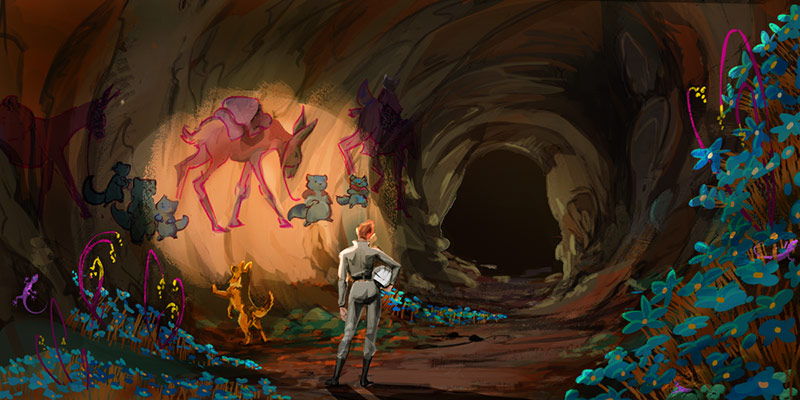
Something wet my hand. My eyes snapped open. Sometime between the waves of shivers and searing pain, my will had given out and I’d fallen asleep.
Bear lay next to me, licking the dry stalker blood off my hand. Her eyes were bright, and when she saw me stir, she sat up and panted.
My back ached, but the suffocating fatigue was gone. I felt strong again.
I flexed. No glitter. In her or in me. We had beaten the flowers.
For a few moments I just sat there, happy to be alive.
Bear danced from paw to paw, looking at my face as if expecting something.
“Are you thirsty?” I took off my helmet and poured some water into it from the canteen. She lapped it up.
The gashes on her shoulder and back had closed. I parted her fur to check. There was a narrow, pink scar, but even that was fading.
What was it Elena said about the stalkers? They soak up bullets like they’re nothing and keep coming.
I still had one stalker heart left. I focused on it, pushing as deep as my talent would let me go. The heart unfurled before me, not just glowing, but splitting into layers of different properties, each with its own color, as it had done when I panicked trying to diagnose Bear. It felt like the most natural thing now, as if my talent always worked this way.
I studied the layers. The toxicity was first, an electric blue. I used to see it as a simple glow. Occasionally I got swirls of color varying in saturation and vibrancy, which my brain somehow interpreted into data, but what I saw now was nothing like it.
My father used to collect topographic maps, detailed reliefs of mountain terrain in different parts of the world, with contour lines and color-coded heights: lighter color for the greater elevation, medium for the mid-lying areas, darker for the valleys. This was exactly like that, except I knew that the valleys were a healthy baseline, and the peaks indicated how much toxins affected a particular body system. Nervous and integumentary systems were barely influenced, the digestive and respiratory were moderately impacted, but the poison wreaked havoc on the endocrine, exocrine, muscular, and circulatory systems.
And I somehow knew that the integumentary system was comprised of skin, hair, nails, sweat, and oil glands. Yesterday I had no idea what that word stood for.
There was no point in puzzling over that. The more pressing issue was that the stalker hearts should’ve killed us. They didn’t. Why?
I focused on the next layer, the one glowing with pale pink under the blue. There was that unsettling feeling of falling through the glass floor again. Another relief, in red this time. It took me a moment to figure it out.
Regeneration.
I hadn’t seen it before, maybe because I was too focused on countering the poison. The stalkers were damn near indestructible. We’ve been targeting the glands in their neck, but given time, they would regenerate those. You had to deal enough damage to cause actual clinical death, otherwise no matter how badly they were wounded, they would bounce back. Good to know.
But the regeneration on its own couldn’t counter that shocking toxicity. More, that was not the way biology functioned. Eating cobra meat didn’t magically give you the ability to produce snake venom. Eating the stalker hearts should’ve just poisoned us, but instead both I and Bear healed our wounds and purged the poison.
On the other hand, regular biology couldn’t account for the emergence of the Talents, compound fractures healing in 7 hours, or a glowing gem passing through solid bone. We were in Arthur C. Clarke territory. Any sufficiently advanced technology was indistinguishable from magic, and this was magic.
I sorted through my environment until I found some pollen traces and split that into layers as well. The toxicity was off the charts. I tried to look at the two of them together, the heart and the pollen, by superimposing one on to the other, but the picture was too complex. After a few seconds, both sets of layers collapsed, and I saw white again. This time I was blind for at least a minute. I had to be careful not to push myself too far.
The best I could figure out was that mixing the pollen and the stalker blood somehow negated their mutual harm while boosting the regenerative properties of the stalker’s heart.
It was a miracle that we survived. A roll of cosmic dice.
Once my vision returned, I flexed again. A quick scan of Bear and my body showed if not outright immunity, then a high resistance to both poisons. We could likely stroll through the flowers now, not that I would risk it unless we absolutely had to, and eating the stalker meat should be safe. At least in theory.
The memory of the horrible battery acid taste sliding down my throat made me shudder.
I checked my shoulder. The bite had knitted closed. The gashes on my legs from the claws had healed too. I had escaped death. Again. I couldn’t tell if it was the magical gem or my newly acquired regeneration. Possibly both.
Bear licked the hat clean and looked at me.
“More?”
I poured a bit more water out. She lapped it up.
My mouth was dry, too. I tipped the canteen and finished what was left. We would need to find a water source soon. Also, I was hungry. So very hungry. I’d taken my watch off because it broke, so I had no idea how much time had passed. I should’ve checked the bodies for a watch, but I didn’t think of it at the time.
It felt like I hadn’t eaten in days. The stalker heart weighed about 2 pounds, and I had eaten a whole one just like it. I should’ve been full, but instead I was starving. Water, food, exit. I needed to find all three.
There was something on the opposite wall. Some sort of shapes…
I picked up the hard hat and flicked the light on.
Cave drawings, depicted in rust red and blue. A procession of some kind of beings, resembling raccoons or foxes, maybe? They were leading weird looking donkeys.
Danger.
A vision unfolded in my mind. A caravan of fluffy creatures departing, some being wrapped in rags begging on the street, and a feeling of alarm. Not deadly danger exactly but ruin. Financial ruin.
The vision faded.
“What do you think this is all about, Bear?”
The shepherd wagged her tail.
“Yes, I don’t know either.”
The woman who called me her daughter, the four-armed killers, and now the foxes, all distinct and morphologically different. Three separate species. Representatives of three civilizations? Or was it one complex society?
What the hell was on the other side of the breaches?
I had no answers and more pressing things to worry about. We had one canteen of water left, so we needed to get a move on. If we found a water source, I would need to wash up. My coveralls were drenched in stalker blood. My hair was bloody too and it stuck to my face and neck. I hooked the empty canteen back to the loop on my coveralls, put the hard hat back on my head, and nodded to my dog.
“Once more into the breach. Living the dream.”
Bear wagged her tail, and we started across the stone bridge.
The post The Inheritance: Chapter 6 Part 3 first appeared on ILONA ANDREWS.
Spotlight on “A Promise to Arlette” by Serena Burdick
A Promise to Arlette has the heart of a thriller, an evocative historical novel following…
The post Spotlight on “A Promise to Arlette” by Serena Burdick appeared first on LitStack.
Monday Meows
I get by with a little help from my friends.
I get high with a little help from my friends.
I’m gonna try with…what’s the next line?
He is very trying, you have to give him that.
I have no friends only adversaries and adoring subjects.
Four Things I Think I Think: May 2025
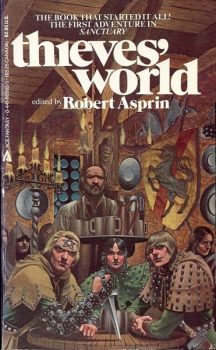 Time to share a few things I Think I Think.
Time to share a few things I Think I Think.
I mean, what’ the point of having your own blog column if you can’t share your opinion on whatever you want to? Right???
1 – The Black Company Remains One of My Favorite Series’
I’ve written multiple times that audiobooks fit my lifestyle these years. I still enjoy reading a print book, and the digital format has made a LOT of long out-of-print Pulp, available. But I listen to audiobooks while I work, write, game, drive, and even fall asleep. I get to stuff I’d not, otherwise.
Last year I listened to the entire Black Company series (minus Port of Shadows). I have read the entire thing at least three times through, and this was my first listen. Last month, as I was doing a couple of long runs, I decided I wanted to listen to The Black Company (book one). during them. And here I am a month later, on Water Sleeps, the second-to-last book (I only have Port of Shadows in hardback, so excluding that from the discussion at present).
The initial trilogy is definitely my favorite part. The last two, my least. But this foundational series in the dark fantasy/grimdark subfield, endures. It remains a terrific read/listen, and I’m excited that the new chapter kicks off this Fall with Lies Weeping (an internet scoop provided by your hard-working columnist last year, here on Black Gate).
The books are told from different characters’ viewpoints, so there are different narrators. They all work, but I like Marc Vietor (Croaker) the most.
If you’ve never read The Black Company, you’re missing out on one of fantasy’s best. If you have read it, you should definitely check out Fletcher Vredenburgh’s series on it, here at Black Gate.
2 – Thieves World Deserves ‘Rediscovery’ Through the AudiobooksI began reading the marvelous shared-world universe of Thieves World back in the eighties, not long after it started. I’ve re-read it multiple times, and I have almost all the spin-off books. MANY an RPG thief/rogue has been named Shadowspawn. And Molin Torchholder has been in play for clerics.
I was thrilled last year to discover that in August of 2023, Audible started carrying the first four Thieves World books! I immediately got all of them, narrated by Jonathan Johns. He sounds like Mackenzie Crook (Gareth in the British The Office; the one-eyed pirate in the Johnny Depp movies). He was an excellent choice.
They just dropped books five and six this month. Kim Morton is the new narrator for five. It’s a step down – his voice is kinda thin. It still works, but John was better. We’ll see how Noni Alley is with book six.
Listening to these audiobooks brings back the magic of Thieves World. I prefer the first books to the latter ones (the Beysib arrival felt like a shifting of the series, to me), so I’m happy these early ones are out. Thieves World was one of the early dark fantasy series, and a terrific multi-author universe. I despise Lynn Abbey’s short-lived reboot, and I wouldn’t listen to those books if they recorded them.
I am a fan of Janet Morris’ spin-off trilogy,with Tempus and the Stepsons fighting the wizards of the Mygadonian Alliance. All three came out last year on Audible, using an AI narrator. I think audiobooks should use human narrators. But I’m not intrinsically opposed to virtual voices. I assume cost is a significant factor; Several of Morris’ older books are now on Audible, with AI narration. I bought volume two, Beyond the Veil, after re-reading book one. It’s a bad narration. Now, I’ve listened to several bad human narrators. But this wasn’t very good. It definitely felt like a computer, not a human. I didn’t bother to get the third audiobook. And it’s the same voice used for one of her old Heroes in Hell books – I passed on that, as well.
But I’m definitely glad they have put out these Thieves World books, and I hope they do the whole original series. Definitely recommended to read and listen to.
3 – The Animated Clone Wars is Terrific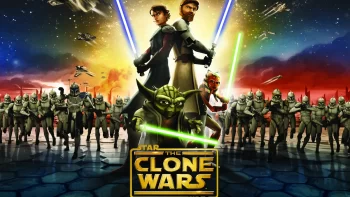 Star Wars Rebels was a really good series with a lot of lore added into the saga. I had seen a few episodes here and there of The Clone Wars, as well as a couple Bad Batch episodes. Clone Wars is my son’s favorite animated series in any genre: and he likes a lot of them. I decided to watch it from start to finish in an attempt to relate better to my teenager (good luck with that – I know).
Star Wars Rebels was a really good series with a lot of lore added into the saga. I had seen a few episodes here and there of The Clone Wars, as well as a couple Bad Batch episodes. Clone Wars is my son’s favorite animated series in any genre: and he likes a lot of them. I decided to watch it from start to finish in an attempt to relate better to my teenager (good luck with that – I know).
Man, this is a terrific series. Love all the lore added/expanded on; the visual style; the action scenes: it’s all excellent. Episodes are a bit less than 25 minutes I think, and easy to binge in small numbers. I’m into season two (there are seven seasons and one hundred thirty three episodes) and while I still find Jar Jar annoying as hell, I like everything about this series. The light saber fights are really cool.
If you like the Star Wars universe and haven’t seen this show yet, you are definitely missing out – like I was. And the Bad Batch was introduced near the end of the original show, and it’s a spin-off series you can follow up with.
There’s a Clone Wars ninety-minute movie that takes place right before the first episode of the Clone Wars series. It introduces Asohka as a padawan. I watched it after watching season one. That didn’t affect anything, and it’s definitely worth watching.
Highly recommend Clone Wars. And if you haven’t seen Rebels, it fills in some of the gap leading right up to the start of the first movie. And, the live-action Asohka series picked up the Rebels story line. Very recommended.
4 – Robert E. Howard Continues to Enthrall Me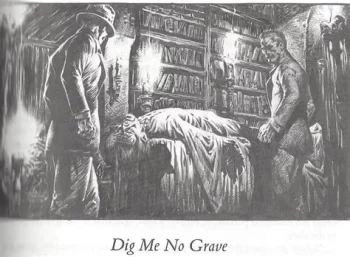 John D. MacDonald remains my favorite writer of all time – any genre. I’m overdue for another dive into his short novels, but that’s just not on tap at present. However, I am continuing to read and re-read my second-favorite: the pride of Cross Plains.
John D. MacDonald remains my favorite writer of all time – any genre. I’m overdue for another dive into his short novels, but that’s just not on tap at present. However, I am continuing to read and re-read my second-favorite: the pride of Cross Plains.
I’ve got the third and final Kirby O’Donnell post coming for the Summer Pulp series (there were only three stories). I’m sure 2026 will see me ruminating on the one Steve Clarney story. But as I re-read “The Curse of the Crimson God,” as always, I was in awe of Howard’s writing skill. His prose is fantastic. He writes battle as well as anyone I’ve discovered. But his use of words, relentless pacing, and facility for spellbinding the reader, feels fresh every time.
I have a post on his occult detectives, Conrad and Kirowan, ready for the Summer. Horror is not my thing, but Howard was a master in that genre, as well. My love of MacDonald goes back more than forty years – he was a master. But Robert E. Howard may be unequaled at what he wrote. Even the prose in his Conan stories rises above the common perception of Pulp, and sword and sorcery. I may not love every story he wrote, but I am rarely disappointed in the writing (Breckenridge Elkins is totally an exception).
If you haven’t discovered REH – or only know Conan – get a couple volumes in the fantastic Del Rey series (they used the original unedited texts) and discover a true American treasure.
Not 5 –I wanted the fifth item to be me praising the terrific documentary, Welcome To Wrehxam. Ryan Reynolds and Rob McElhenney bought the Welsh soccer (football) club in Wrexham, in 2001. The whole thing has been covered in a wonderful documentary. The first episodes of season four dropped earlier this month. I’m not caught up yet.
But it is SO watchable. The owners, the team, the staff, and the town – you will get invested in all of them. The boys have (sometimes painfully) plugged in a lot of cash, and reaped ongoing success. Ryan and Rob are really fun and likable guys.
I’ll talk about Wrexham in a future What I’m Watching installment.
Prior Ten Things I Think I Think
Six Things I Think I Think (March 2025)
Ten Things I Think I Think (January 2025)
Ten Things I Think I Think (December 2024)
Nine Things I Think I Think (October 2024)
Five More Things I Think: Marvel Edition (September 2024)
Ten Things I Think I Think: Marvel Edition ( September 2024)
Five Things I Think I Think (January 2024)
Seven Things I Think I Think (December 2023)
Talking Tolkien: TenThings I Think I Think (August 2023)
A (Black) Gat in the Hand: Ten Things I Think I think (August 2023)
5 More Things I Think (March 2023)
10 Things I Think I Think (March 2023)

Bob Byrne’s ‘A (Black) Gat in the Hand’ made its Black Gate debut in 2018 and has returned every summer since.
His ‘The Public Life of Sherlock Holmes’ column ran every Monday morning at Black Gate from March, 2014 through March, 2017. And he irregularly posts on Rex Stout’s gargantuan detective in ‘Nero Wolfe’s Brownstone.’ He is a member of the Praed Street Irregulars, founded www.SolarPons.com (the only website dedicated to the ‘Sherlock Holmes of Praed Street’).
He organized Black Gate’s award-nominated ‘Discovering Robert E. Howard’ series, as well as the award-winning ‘Hither Came Conan’ series. Which is now part of THE Definitive guide to Conan. He also organized 2023’s ‘Talking Tolkien.’
He has contributed stories to The MX Book of New Sherlock Holmes Stories — Parts III, IV, V, VI, XXI, and XXXIII.
He has written introductions for Steeger Books, and appeared in several magazines, including Black Mask, Sherlock Holmes Mystery Magazine, The Strand Magazine, and Sherlock Magazine.
You can definitely ‘experience the Bobness’ at Jason Waltz’s ’24? in 42′ podcast.
When Satire is Overwhelmed by Reality: Moon Missing: Edward Sorel’s Report on Future Events
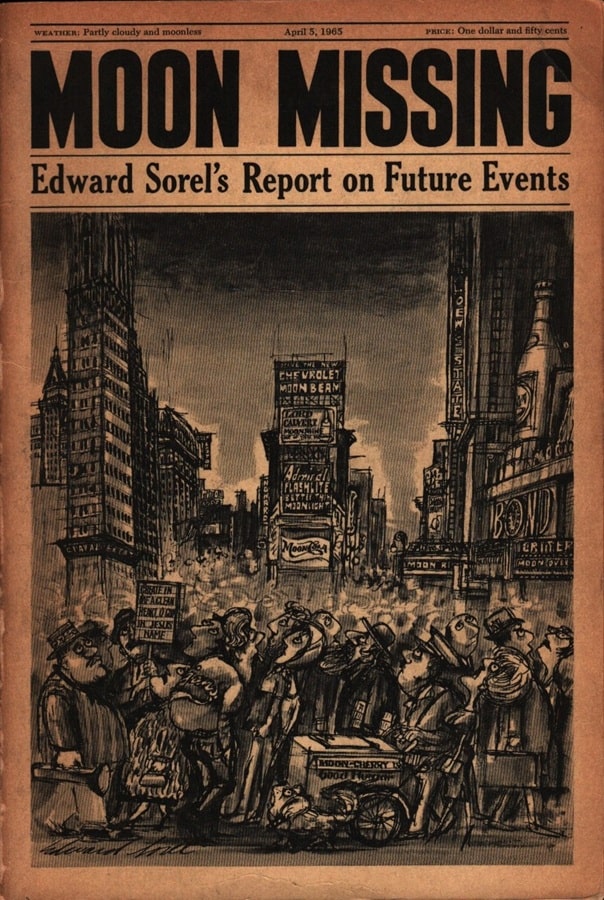 Moon Missing (1962)
Moon Missing (1962)
At about 1:46 am EST in the middle of the American night of April 4, 1965 the Moon disappeared. The American people were informed the next day at a Presidential news conference. President Kennedy was in no way responsible, said Allen Dulles, disgraced former CIA director but now Secretary of the Exterior, tapped to safeguard American interests in outer space.
Cartoonist, caricaturist, satirist Edward Sorel published Moon Missing in 1962. He had no need to prognosticate the future; the world around him gave him all the ammunition his ink Speedball B6 required.
So insistent are we today that the early Sixties were a more innocent time that the reality of the fear, paranoia, tension, and general unhappiness of the era can only be exhumed from period pieces. Sorel’s vision of the craziness ready to be let loose by a global event relied heavily on contemporary names in the news, but to find frighteningly many parallels in today’s world the names need only to be changed to modern equivalents.
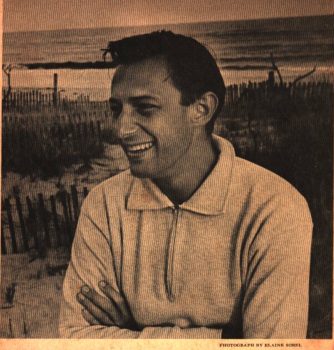 Edward Sorel in 1962
Edward Sorel in 1962
Born Edward Schwartz in 1929, Sorel found his artistic future while spending a year in bed as a child, much as young Richard Starkey found the drums as solace during a similar confinement. Still alive today and very much the Grand Old Man of caricature and cartoon satire with an endless catalog of important works, Sorel was a struggling freelancer in 1962. His early books for adults were such failures that even his own website doesn’t bother to mention them. To supplement the advertising work he was building a reputation for, he sent his satires out to every magazine that would accept such heresy, keeping his name before the public.
Moon Missing was excerpted in the motley foursome of Horizon, Sports Illustrated, Show Magazine, and Caterpillar. Caterpillar? Since the avant garde The Caterpillar Magazine didn’t debut until 1967 and the children’s magazine of that name was far in the future, I am forced to conclude he meant Caterpillar News and Views, the house magazine of the bulldozer giant. To imagine the improbability of that Venn diagram, try to conjure an appearance by R. Crumb in IBM’s THINK magazine. My brain boggles.
Moon Missing is set as a series of brief daily newspaper reports from the alternate future of 1965, the foundation Sorel uses for his plethora of illustrations. The double-page below sets the tone. New Yorkers parade down the sidewalk, oblivious to all but their smartphones – I mean, newspapers – while the news ticker accuses the Communists for the disappearance.
First to react is the Gallup Poll. The public is eternally divided on all issues.
And politicians are eternally hypocrites.
Clueless politicians can be found in every era, but the sweetener here is the reminder that J. Edgar Hoover used the FBI as a personal internal police, a part of the past we should never want revisited. “Involves national security.” Ring any recent bells?
Every bit of today’s battle of right and left wings already existed in 1965.
So much commentary is packed into these two pages alone.
Lest you think Sorel was himself nothing more than a muddle-headed liberal, be assured that he applied his gimlet eye to the Kennedy administration as well.
Fortunately for the economy, capitalists will always find a way to cope.
As world tensions soar, Kennedy and Khrushchev meet and sign a Mutual Moon Aid Pact, and talk about complete disarmament. And then the worst possible news.
 Look at the date. July 4. If you were Khrushchev would you think that was a coincidence? Or would even Americans? So much for world peace.
Look at the date. July 4. If you were Khrushchev would you think that was a coincidence? Or would even Americans? So much for world peace.
And Sorel, the old advertising guy, can’t help but add a coda that triggers the memories of us graybeards.
The book should have been a bestseller. Unfortunately for Sorel’s career, Moon Missing was published on the first day of the sensational and long-lasting New York newspaper strike. Few events speak more to New York’s absolute cultural dominance over the country in the early sixties. All other media took their cues from the New York papers. Anything not reviewed there had little chance of notice, much less success, elsewhere. The rave review in the Tampa Tribune didn’t save it. Kennedy’s assassination the next year thoroughly destroyed any chance of a later revival; reading about a living Kennedy presidency in 1965 would be little more than a sick joke, sicker than the ones Sorel actually told. (The hard-luck Sorel later created a poster attacking the war-mongering Cardinal Spellman of New York, but it was released the day the cardinal died. Live by satire, die by irony.)
The good news is that in 1963 Sorel was named art director of Monocle, a magazine of savage political satire that matched his sensibilities perfectly. From there he went to Ramparts, New York, and the National Lampoon, and was discovered by more mainstream magazines, seldom disguising his disdain for all that was wrong with society and politics. For me he will always be indelibly etched in my memory for his nsfw drawing of a rockette line of nude world leaders covering their private parts with large erect rockets pointed at the rest of humanity. If you dare, search for Robert Scheer’s Thinking Tuna Fish, Talking Death: Essays on the Pornography of Power, the most perfect title for a Sorel cover ever devised.
ETA: I have a coda as well and it may be less believable than Sorel’s satire. We live in a time when satire is overwhelmed by reality. Only datelines can differentiate them. While writing this article my eye was caught by a report on American First Policy Institute ambassador Kambree Nelson. Nelson was invited to the White House’s “new media” press conference for influencers where she gained attention for a particularly softball question, leading the curious to check her history. They quickly discovered that in October 2024 she sent a Xitter out to her 625,000 followers: “Has anyone seen the moon lately? I’ve been looking for 7 days.” When even some of her followers told her that the moon was right up there, she replied. “It’s not out. None of my friends in 4 states can find it.”
Tom Lehrer once proclaimed, “Political satire became obsolete when Henry Kissinger was awarded the Nobel Peace Prize.” Ironically, both he and Edward Sorel have lived to see this brave new world. Irony may not be dead, but satire is limping with both feet.
Steve Carper is the author of hundreds of articles on fascinating, if obscure and forgotten, tidbits of history, as well as the seminal book Robots In American Popular Culture. All of his websites are linked at SteveCarper.com.
Tubi Dive, Part VII
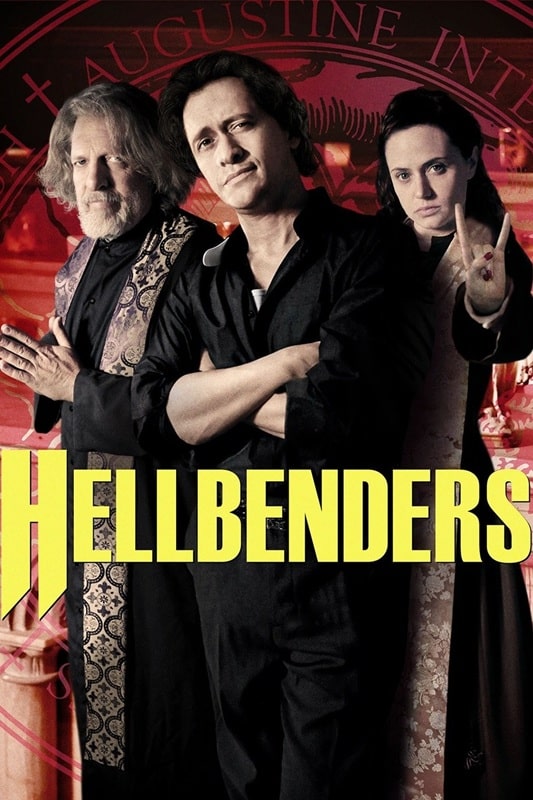 Hellbenders (Lionsgate, October 18, 2013)
Hellbenders (Lionsgate, October 18, 2013)
50 films that I dug up on Tubi.
Enjoy!
Hellbenders (2012)I really should have saved this for later, for my exorcism watch-a-thon What Possessed You, but the mere thought of not watching a Clancy Brown movie kicked off my hives.
Hellbenders is an unholy romp written and directed by J.T. Petty (who brought us The Burrowers, among others) based on the graphic novel of the same name.
It concerns a secret order of multi denominational priests who are trained to defeat unbeatable demons. They do this by sinning as much as possible, then inviting the demon to possess themselves before committing suicide and dragging the entity to Hell. It’s a fantastic premise, and the numerous references to their sins (ranging from stealing newspapers and having disparaging thoughts, to committing adultery and colourful blasphemy) is a lot of fun. Priests aren’t sent out on exorcism missions if they’re not guaranteed to go to Hell.
Clancy Brown plays Father Angus, the leader of this motley troop, and possibly the greatest user of profanity I have ever seen. This film is worth it for his swearing alone, but for God’s sake don’t do a drinking game based on the number of times he says cocksucker — you will die.
Everyone in this cast does a great job, and I especially enjoyed Dan Fogel as a punchy priest, and Stephen Gevedon as ‘Clint’ (a hilarious animated segment reveals why “Clint’ shouldn’t be a superhero name).
The possessions are fugly, the violence is daft and bloody, and there’s lots of biting off of appendages.
I really enjoyed this one.
9/10
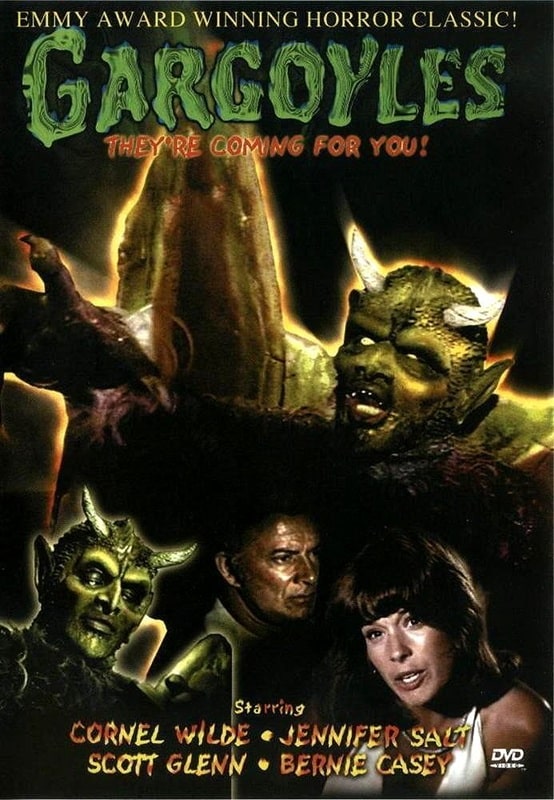
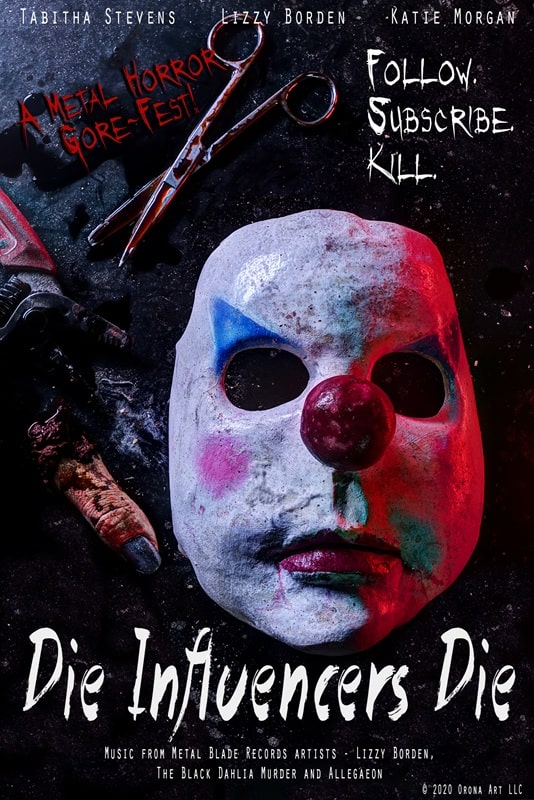
Gargoyles (CBS, November 12, 1972) and Die Influencers Die (Orona Art, 2020)
Don’t get excited, fans of the cartoon show (and potential Kenneth Branagh movie), this is a made for TV movie that was not bad for its time, and has developed something of a cult following.
Cornel Wilde and Jennifer Salt play Dr. Mercer Boley and his daughter, Diana. Dr. Boley is a leading authority on demonology, and his daughter feeds his obsession with trinkets she picks up around the world. They travel to a remote area in New Mexico called Devil’s Crossing — an area steeped in folklore and legend. There they encounter Uncle Willie, the owner of a roadside museum, who shows them a funky skeleton — before you know it, the gargoyles attack, and all hell breaks loose.
It’s a fairly tame flick, with a couple of slightly creepy moments, but the gargoyles don’t really stand up to scrutiny under the harsh lighting, and the action scenes are mostly choppy slow-motion. However, it licks along at a fair old pace, and it does feature Scott Glenn as a bad boy biker. You could say there’s an allegory blanketed under all of this regarding the treatment of indigenous peoples at the hands of settlers, but I ain’t here for no history lesson, mama.
Only recommended for the gargoyle-curious.
5/10
Die Influencers Die (2020)If you know me, there’s nothing I like more than seeing harm come to a) matadors, and b) internet pranksters, so this title obviously whetted my appetite.
Known in Germany as The Influencers, The (a Simpsons gag for loyal followers), this film is a low-budget schlock-fest with very little in the way of redeeming features. The nonsensical story concerns an abusive, toxic alpha-male influencer (a cross between Mr. Beast and Patrick Bateman) who wants to destroy the ‘careers’ of three rival influencers in order to ramp up his views. He does this by inviting them to a ‘haunted film studio’, then tries to give them dysentery with a made up energy drink that they are supposed to hawk for him. Little does he know that a malevolent demon is on site, and ready to chop up and eat anything in her path.
Said demon is the resurrected body of a model that was murdered by one of his assistants and stuffed in a fridge. She walks around at a jerky pace due to edited frames in a clown mask with duct taped nipples and a tutu. She’s apparently there for revenge, so why she kills the duped influencers (who did nothing to her) makes no sense. The whole thing is shot and edited like the most annoying music video you can think of, and is full of shock metal, partly due to the presence of Lizzy Borden as an illogical demon whisperer.
It’s annoying, grating and mean-spirited, and I can only recommend it to folks who like metal, plastic knockers and overacting.
3/10
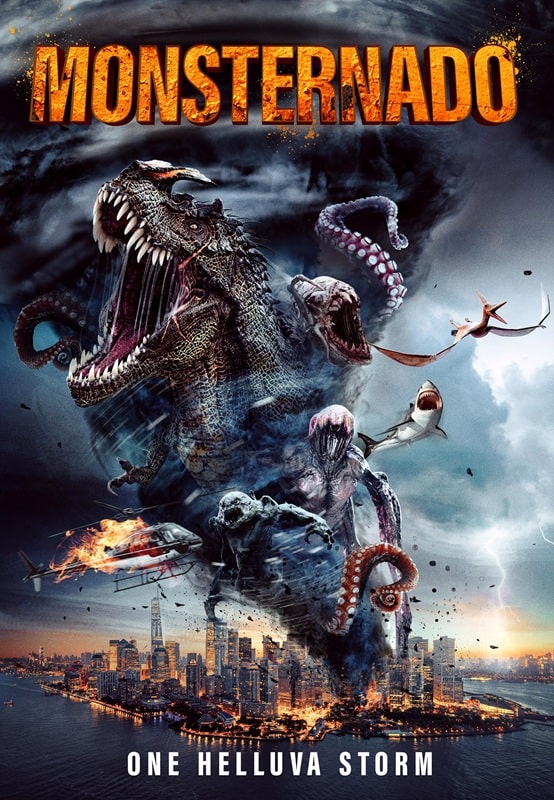
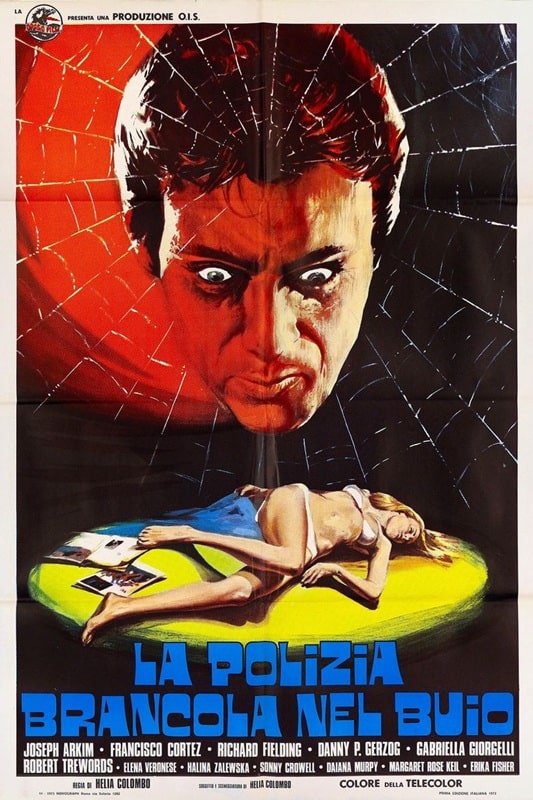
Monsternado (Uncork’d, November 14, 2023) and
The Police are Blundering in the Dark (O.I.S. Cinematografica, 1975)
Still on a kaiju high after Godzilla vs Kong, I foolishly tried to scratch my itch with this (potentially) fun flick. No sooner had it started, than I realized my mistake. It is an Uncork’d production.
Uncork’d makes The Asylum look like A24, but I bravely soldiered on.
Let’s get all the negativity out of the way. It’s not very good. The script is terrible, the acting is rubbish, and the effects are wonky at best.
I lied, here’s some more negativity. The thing that really irked me about this Sharknado knock-off was the filmmakers’ potential to do something really interesting with this idea. If you are going to have a plot reference mythical places like the Bermuda Triangle and Atlantis, then get some mythical monsters up in this windy shit.
As is, we are subjected to sharks, tentacles, gators, snakes, some token pterodactyls and aggressive scampi. If you’re going to spend the catering budget on CG, then at least make the monsters unique and fantastical.
I think it was supposed to take place in the US, but several shots of the Gherkin in downtown London, plus lots of dodgy American accents, gave up its true origins, and just keeping it set in England would have been a slight improvement.
It’s like I sometimes say to my children, “No, I’m not angry with you, just very disappointed.”
3/10
The Police are Blundering in the Dark (1975)Fancied a giallo, and this title caught my eye. It was originally titled The Salad Garden, and that would have made just as much sense, as there’s no actual coppers in this (ultimately rather dull) murder mystery.
The film has all the ingredients of a giallo, a POV killer dispatching young women, mandatory nudity, sexual repression, long talks around the dinner table, male hair product, but this one brings a science fiction twist to the proceedings. A wheelchair-bound photographer has invented a machine (the kind that goes wooo, woooo, and bathes the user in purple) that can photograph people’s thoughts — but this doesn’t really come into play until the end of the movie.
Instead we follow the apathetic investigation of a journalist looking for his missing friend while trying to pop the cherry of anyone he comes across. Being Italian and mid-70s, no one can be killed before their shirt has come off, in fact in the opening scene, the killer kindly tears his victim’s blouse so that she can gallop breastily through a copse before she becomes a corpse.
Possibly the most boring giallo I’ve ever watched, so I can only recommend it to fans of the Italian countryside, small cars, bosoms and lettuce.
4/10
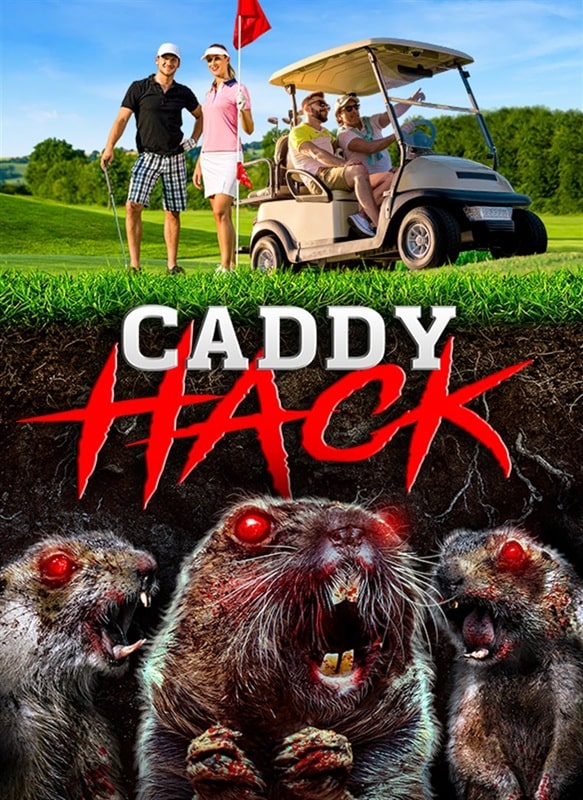
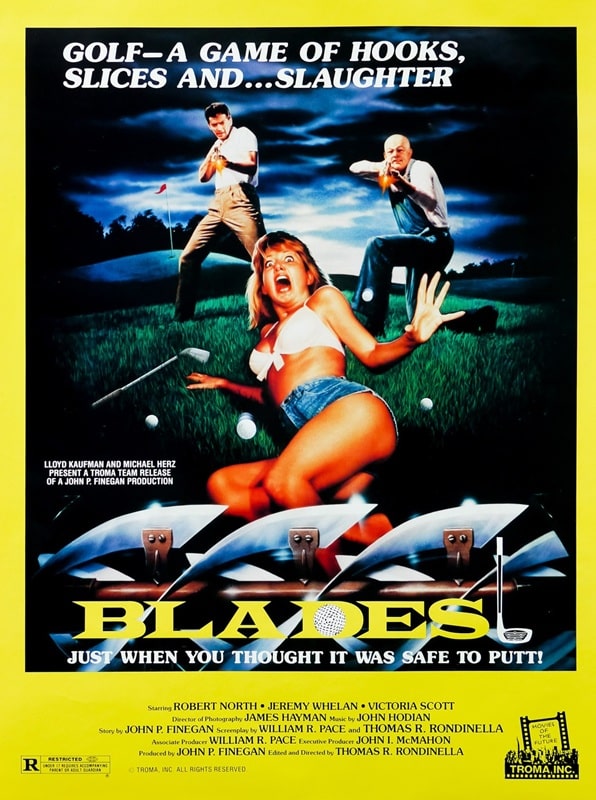
Caddy Hack (Wild Eye Entertainment, December 10, 2023) and Blades (Troma Entertainment, 1989)
A double-bill, you lucky people. Here we have a pair of golf-related horror films that are on opposite ends of the quality spectrum.
Caddy Hack is bloody awful. It purports to be a comedy, but it is so desperately unfunny that I ended up hate-watching it for the final hour. The style of humor put me in mind of Mad Cow; self-referential, endlessly repeated (unfunny) jokes, deliberately rubbish effects, extreme mugging for the camera, horrible editing, and so on.
The story dispenses with the whole Caddy Shack plot, and instead focuses on the gophers, which in this steaming pile have been mutated by fertilizer. Throw in a Trumpy business owner, a thousand ‘ball’ jokes, and a Gremlins rip-off, and you have a recipe for a warm crap casserole. Avoid.
On the flip-side, Blades was an unexpected joy. I was honestly expecting a second-tier slasher featuring a lump of machinery, but I received a brilliant homage to Jaws, right down to the sound-alike music, story beats and set pieces. They played it straight, which elicited much more laughter from me than Caddy Hack, and a lot of thought was put into the direct adaptation of the original shark film. It gets better as the film goes on because you realize what’s coming up, and for this reason I wholeheartedly recommend Blades, especially for lovers of Jaws.
1/10 and 8/10 respectively.


Psycho Gothic Lolita (Pony Canyon, September 4, 2010) and Destroy All Neighbors (Shudder, January 12, 2024)
You did it! You’re about to read your 50th rubbish review of a film to be found in the bowels of Tubi!
It took me a while to settle on a final film. I started on Screecher of the Lagoon, but I’m tired of badly shot and acted efforts. I also started The Door in the Woods, but it was too serious for me to get into (I’ll return to it one day). So here we are.
Psycho Gothic Lolita (original title: Gothic & Lolita Psycho) sounded like a perfect fit. After all, I love psychos, I love ‘gothic’ and, um, I love psychos.
The film perfectly encapsulates the vibe of this entire watch-a-thon; bonkers action, extreme gore, body horror, dubious sexiness, and the sort of deadly umbrella that would make John Steed wet his pants.
It’s a revenge tale as old as time. Yuki’s mom is brutally killed by a gang of five ne’er-do-wells in black windbreakers, and so she dresses up as a ‘gothic Lolita’ (I just learned this is a thing) and exacts revenge Kill Bill style. Actually, there’s a lot of Kill Bill in this, right down to an eyepatch-sporting hit woman called ‘Elle’. There’s even a spoon-bender (who’s more proficient at lifting up skirts) called Yuro Gerao — which elicited a hearty guffaw from me.
It’s daft, bloody, and a heap of fun. A good way to go out.
8/10
Bonus Flick! Destroy All Neighbors (2024)Not a Tubi Dive (this is streaming on Shudder/Prime), this one is a deliriously fun throwback to the bonkers weird-a-thons of the 80s. Think Society, Brain Damage or Freaked.
Jonah (MST3K) Ray plays Will, a musician who just wants to finish his prog rock album. As he descends into madness, many unfortunate and bloody events occur, and he ends up in a world of wise-cracking corpses and insane riffs.
It’s obvious everyone is having a great time making this, and Alex Winter chews the scenery under 50lbs of rubber as an East-European nightmare, while Ray is an excellent straight man to the chaos. Daft, messy and entertaining.
8/10
Here are all 50 films I watched on Tubi, and my three favorites — a handy guide for purveyors of slop.
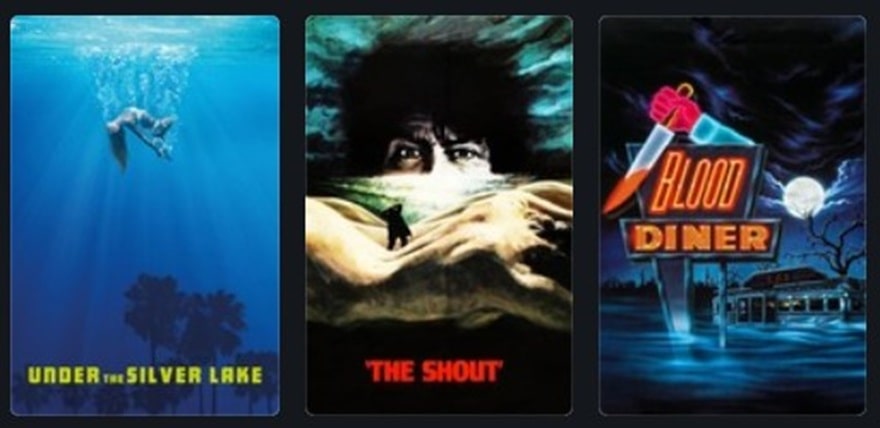 Tubi Dive — The Top Three
Tubi Dive — The Top Three
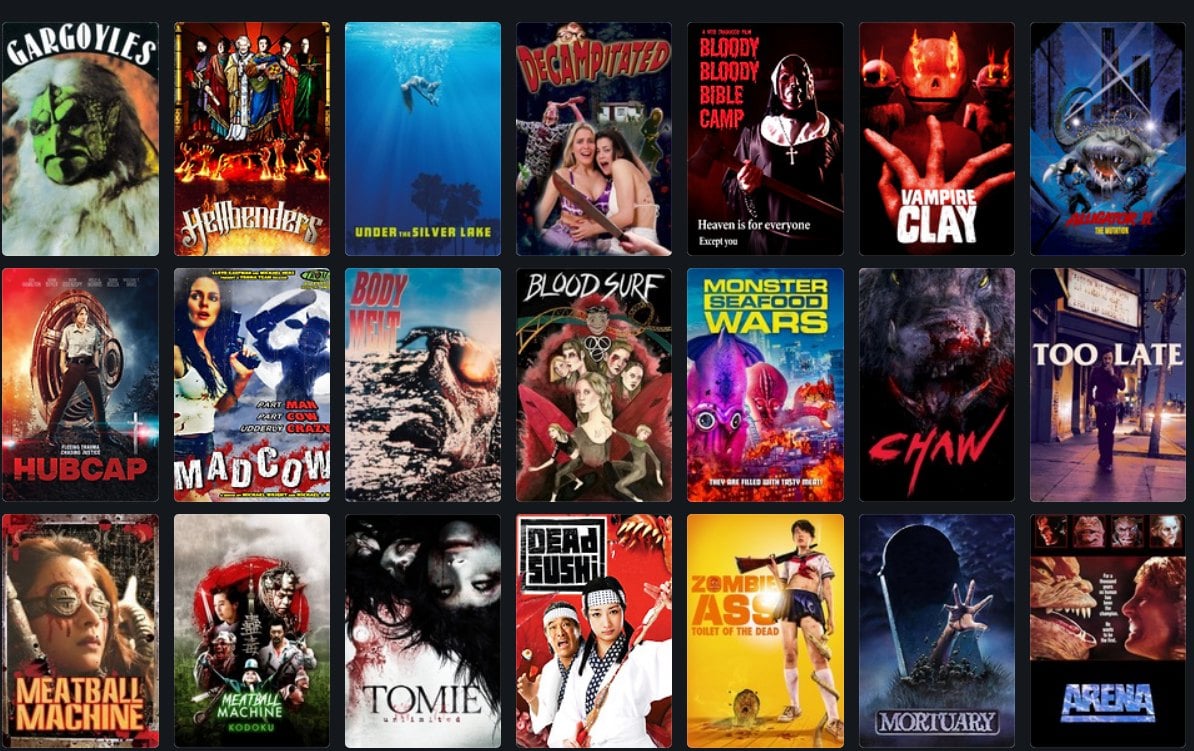 Tubi Dive 1
Tubi Dive 1
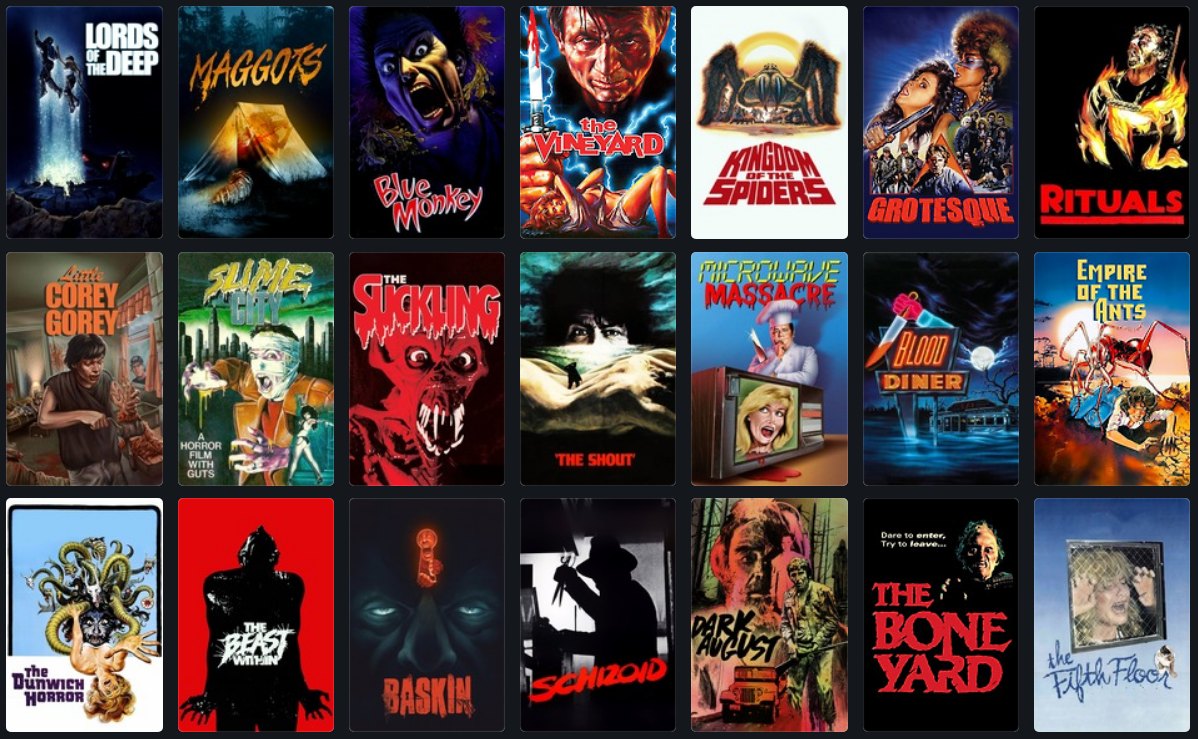 Tubi Dive 2
Tubi Dive 2
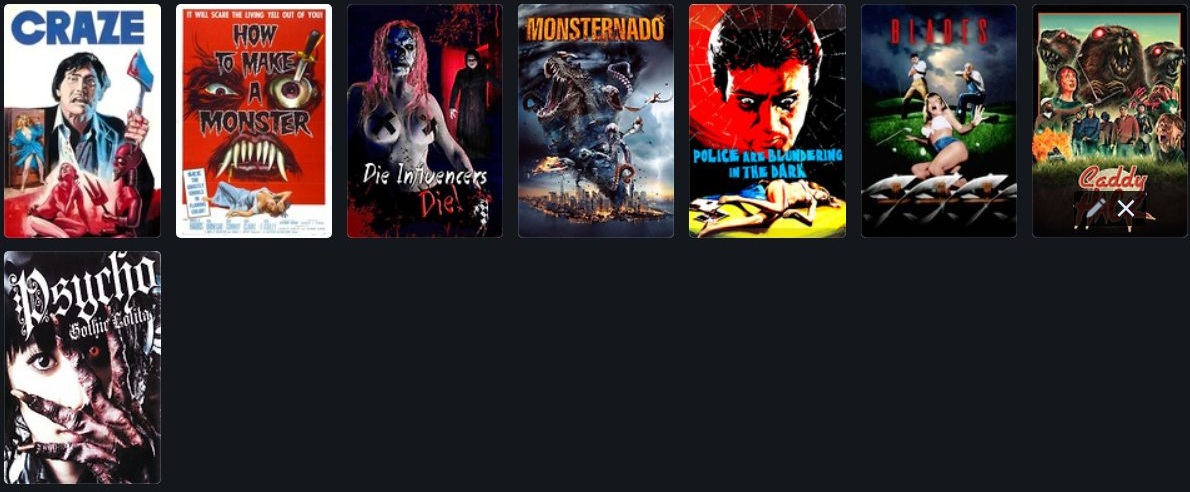 Tubi Dive 3
Tubi Dive 3
Previous Murkey Movie surveys from Neil Baker include:
Tubi Dive, Part I
Tubi Dive, Part II
Tubi Dive, Part III
Tubi Dive, Part IV
Tubi Dive, Part V
Tubi Dive, Part VI
What Possessed You?
Fan of the Cave Bear
There, Wolves
What a Croc
Prehistrionics
Jumping the Shark
Alien Overlords
Biggus Footus
I Like Big Bugs and I Cannot Lie
The Weird, Weird West
Warrior Women Watch-a-thon
Neil Baker’s last article for us was Part VI of Tubi Dive. Neil spends his days watching dodgy movies, most of them terrible, in the hope that you might be inspired to watch them too. He is often asked why he doesn’t watch ‘proper’ films, and he honestly doesn’t have a good answer. He is an author, illustrator, teacher, and sculptor of turtle exhibits. (AprilMoonBooks.com).
In Their Prime – 5 Scary Novels from the 1970s You Must Read
You can find and buy the books we recommend at LitStack on Bookshop at LitStack…
The post In Their Prime – 5 Scary Novels from the 1970s You Must Read appeared first on LitStack.


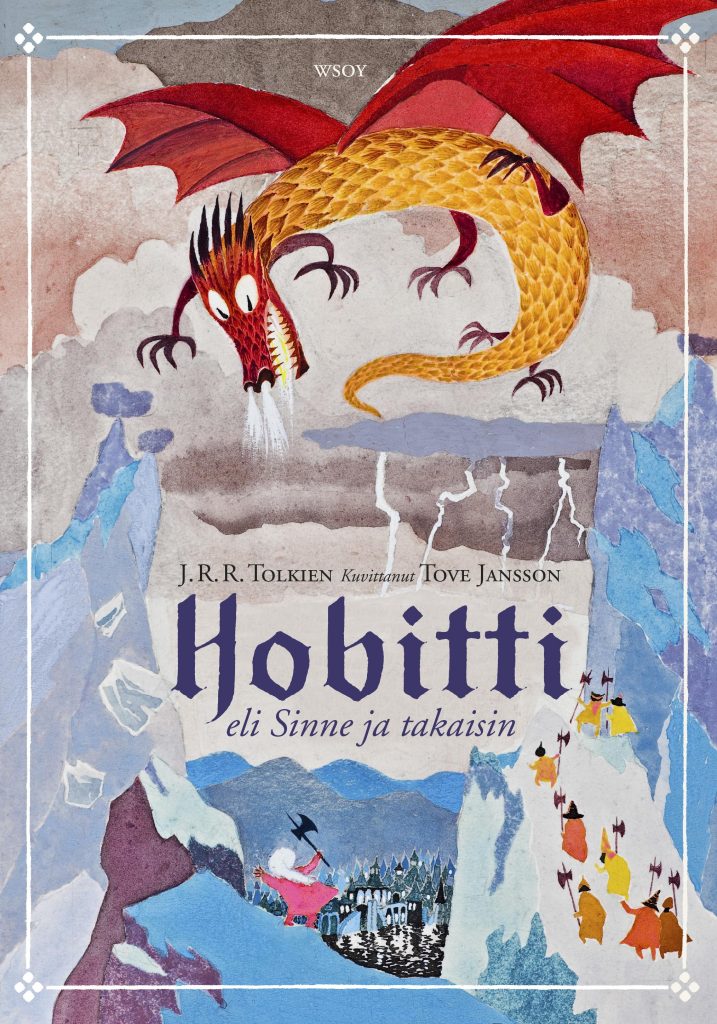

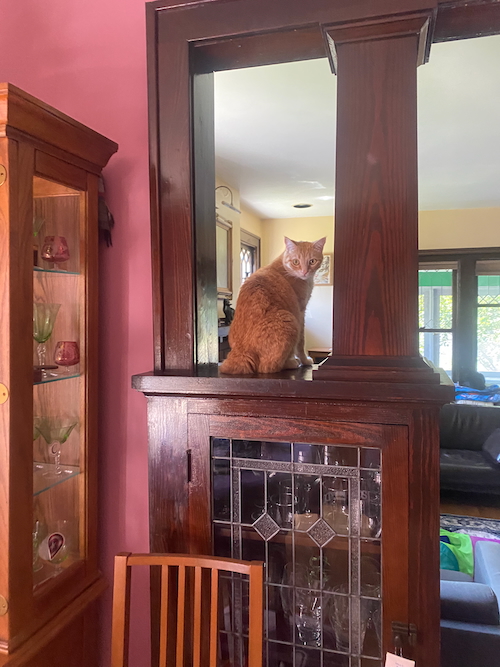

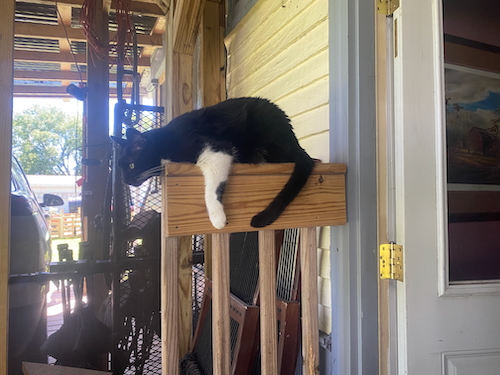
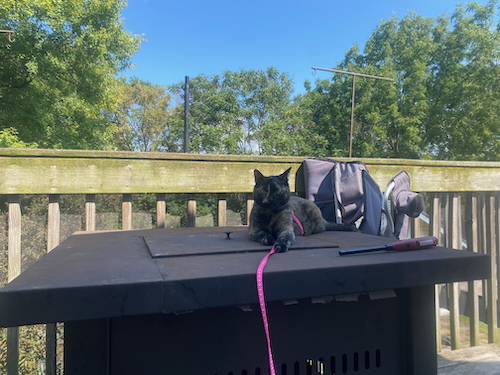




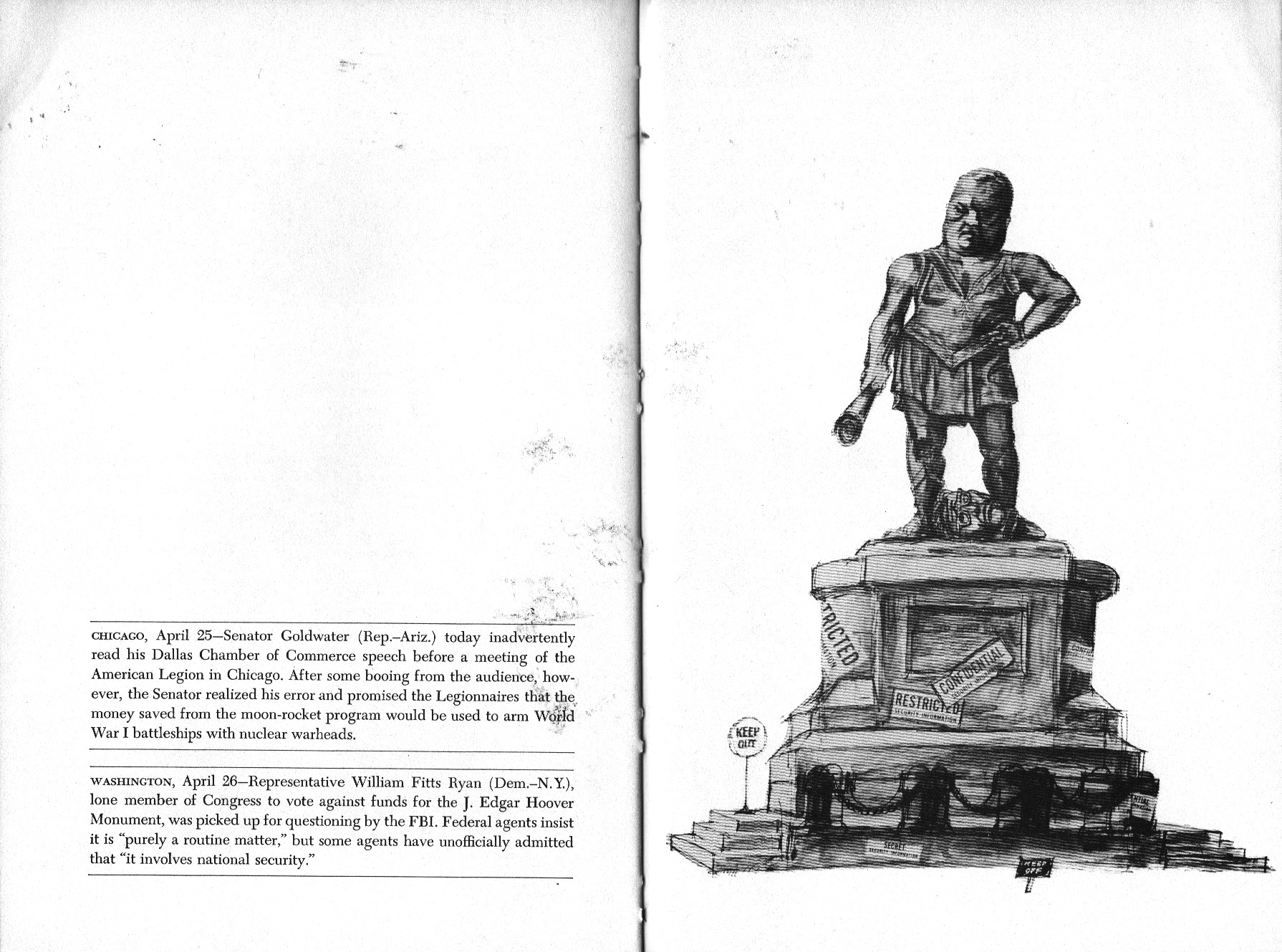

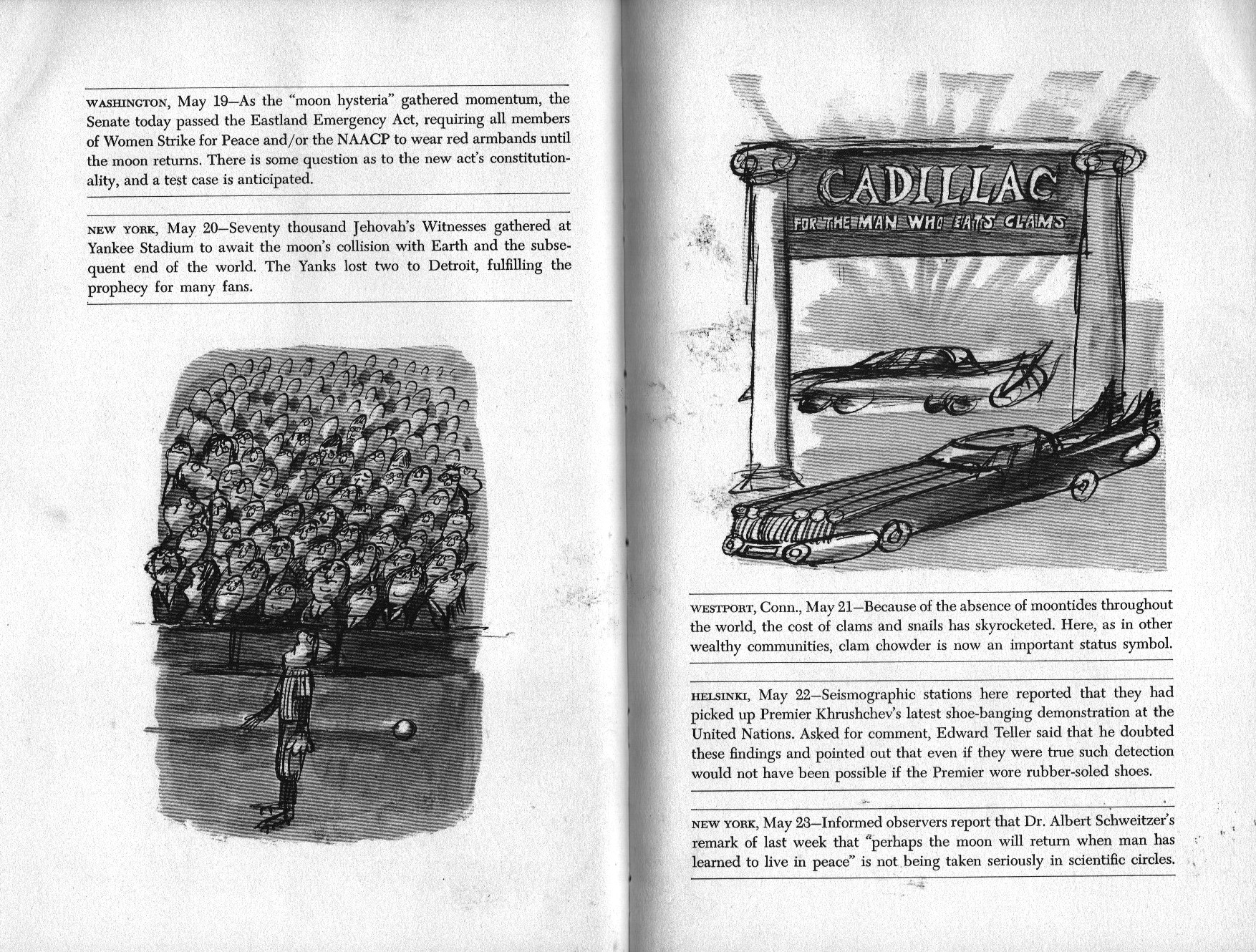
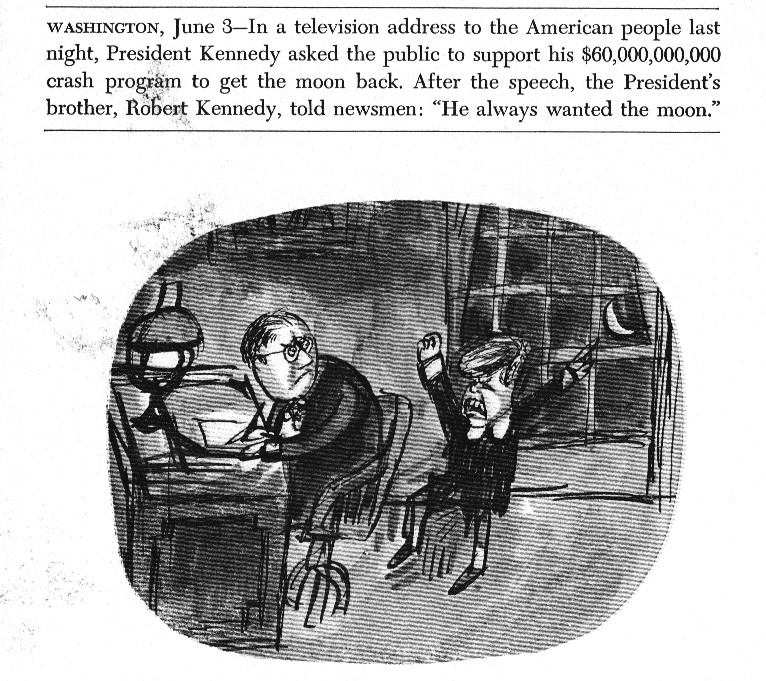
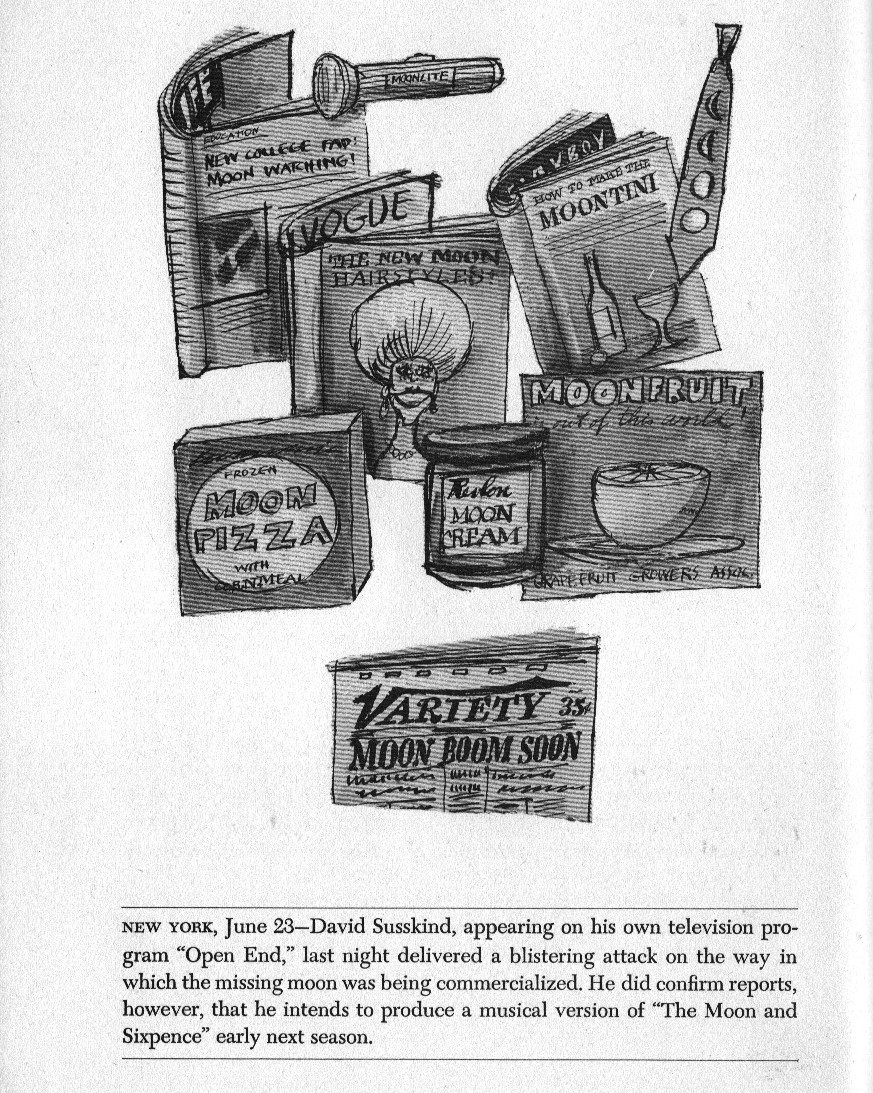
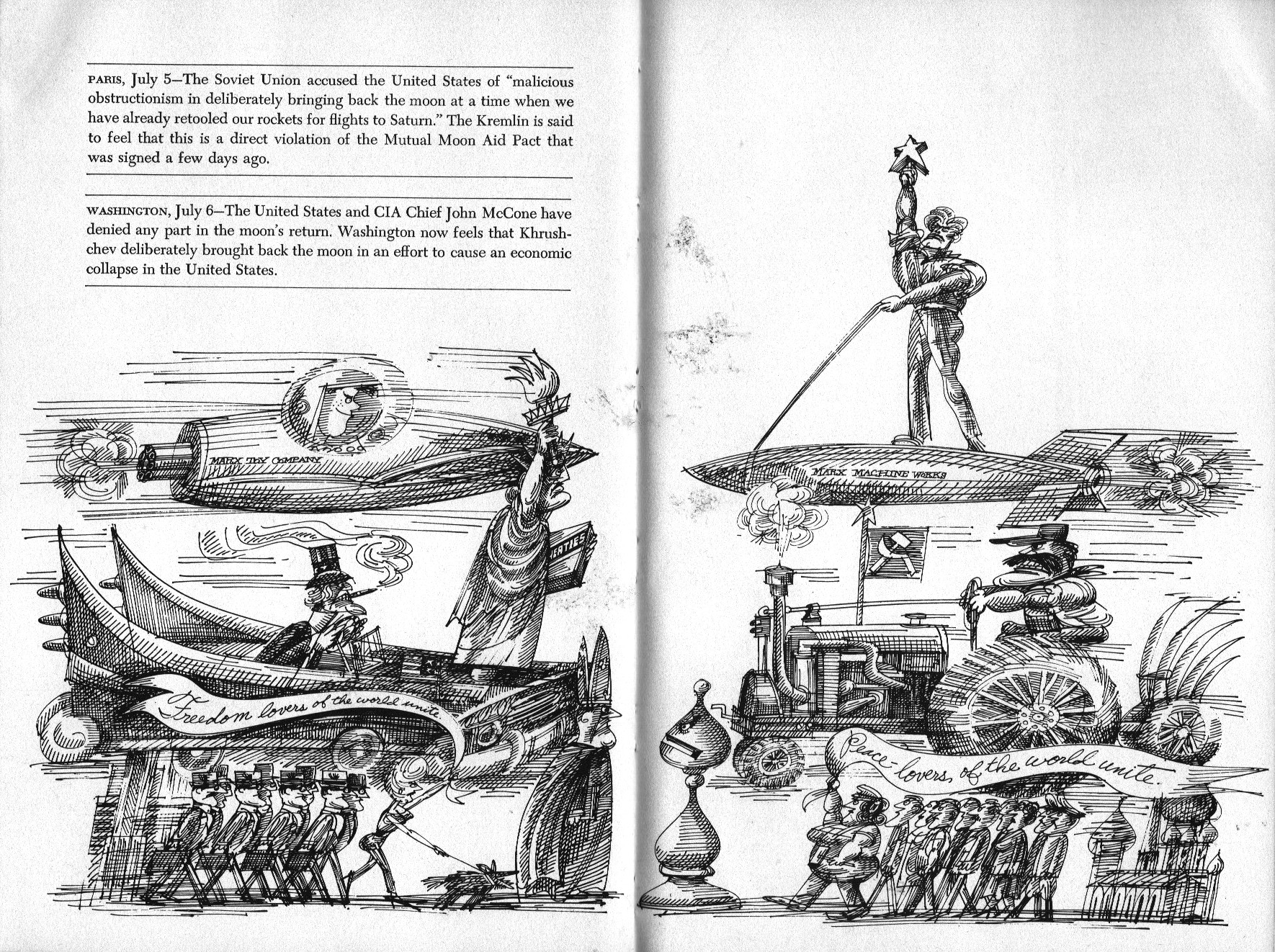
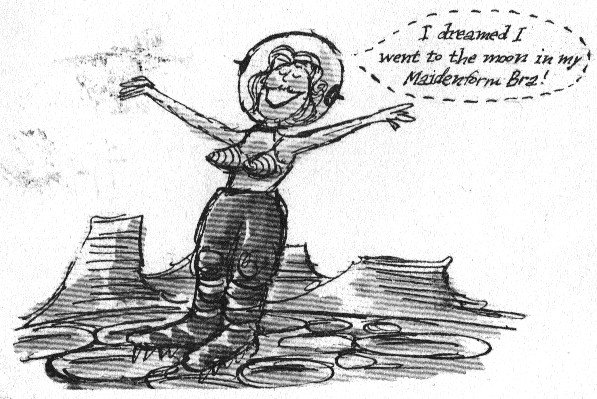
Recent comments